#which i believe preserving and translating the story is the top priority
Explore tagged Tumblr posts
Text
I was about to rush through more of the main chapters of Exedra today and then they hit me with Magia Record chapters so i'd probably be a lot further level wise but... Arc 1 hehehe uwu i miss it. So i read it.
I noticed some slimming down which i guess makes sense. since Exedra wants to jump around and show off many stories from the franchise but idk. The game had so so much story and character building. Also no voices? :( sad. Hope they get added in eventually
#though i guess i could re-read arc 1 now that i have access to the beta private server...#calling it beta cause its still being worked on and when I see people just say private server others expect like a fully done replica of it#which isn't the case but very usable for reading the story!#which i believe preserving and translating the story is the top priority#And you can do some battles and stuff but i will say applying memos is hell since the beta ver. has everything unlocked and you have every#memo to sort through#but there is a level 999 livia in support so thats fun. i love livia and now she one shots everything#It is cool to have everything unlocked but i will wait patiently for when i can add my old data back :)#but i probably will use it for reading purposes eventually#especially since i want to compare to the Exedra adaptation of arc 1 & hopefully 2...#but like also i could just go to youtube lolol#i have to start up bootcamp if i want to play the dang thing#sorry for long tags lol#i just like yapping in the tags#i also i do like this game but as a video game appreciator and gacha player#I can tell this game was a bit rushed#and when i consume on that...#i get agitated cause we should have had like one more year with record while Exedra got the polish it deserves#but its whatever this is the hand we have been dealt#but if i didn't have blinders on for this franchise i wouldn't touch this game#Like if you are not interested in anything from the story#characters#or designs#the gameplay wouldn't keep you hooked.#which i guess isn't the biggest deal i guess idk#Madokas popular i imagine a guaranteed 3 years with this game and then depending on how its doing will give of us some insight on if it wil#continue
0 notes
Text
we, as children of Light are first chosen by God
who waits for us to respond to His call. this is the purpose of the preservation of the Scriptures, to conserve spiritual truth in Love, and God is Love.
and so we find our True identity in faith and in a promised hope of things to come, that will be...
to come to “believe...” in the heart and to speak as a mirroring of what is treasured (inside, Anew)
and so, the seed of faith is deposited within as a treasure that waits to be discovered, it is (already inside)
and we read of this faith and hope that includes Hebraic History in Today’s chapter of Paul’s ancient Letter of Romans with chapter 9 as translated in The Message:
[God Is Calling His People]
At the same time, you need to know that I carry with me at all times a huge sorrow. It’s an enormous pain deep within me, and I’m never free of it. I’m not exaggerating—Christ and the Holy Spirit are my witnesses. It’s the Israelites . . . If there were any way I could be cursed by the Messiah so they could be blessed by him, I’d do it in a minute. They’re my family. I grew up with them. They had everything going for them—family, glory, covenants, revelation, worship, promises, to say nothing of being the race that produced the Messiah, the Christ, who is God over everything, always. Oh, yes!
Don’t suppose for a moment, though, that God’s Word has malfunctioned in some way or other. The problem goes back a long way. From the outset, not all Israelites of the flesh were Israelites of the spirit. It wasn’t Abraham’s sperm that gave identity here, but God’s promise. Remember how it was put: “Your family will be defined by Isaac”? That means that Israelite identity was never racially determined by sexual transmission, but it was God-determined by promise. Remember that promise, “When I come back next year at this time, Sarah will have a son”?
And that’s not the only time. To Rebecca, also, a promise was made that took priority over genetics. When she became pregnant by our one-of-a-kind ancestor, Isaac, and her babies were still innocent in the womb—incapable of good or bad—she received a special assurance from God. What God did in this case made it perfectly plain that his purpose is not a hit-or-miss thing dependent on what we do or don’t do, but a sure thing determined by his decision, flowing steadily from his initiative. God told Rebecca, “The firstborn of your twins will take second place.” Later that was turned into a stark epigram: “I loved Jacob; I hated Esau.”
Is that grounds for complaining that God is unfair? Not so fast, please. God told Moses, “I’m in charge of mercy. I’m in charge of compassion.” Compassion doesn’t originate in our bleeding hearts or moral sweat, but in God’s mercy. The same point was made when God said to Pharaoh, “I picked you as a bit player in this drama of my salvation power.” All we’re saying is that God has the first word, initiating the action in which we play our part for good or ill.
Are you going to object, “So how can God blame us for anything since he’s in charge of everything? If the big decisions are already made, what say do we have in it?”
Who in the world do you think you are to second-guess God? Do you for one moment suppose any of us knows enough to call God into question? Clay doesn’t talk back to the fingers that mold it, saying, “Why did you shape me like this?” Isn’t it obvious that a potter has a perfect right to shape one lump of clay into a vase for holding flowers and another into a pot for cooking beans? If God needs one style of pottery especially designed to show his angry displeasure and another style carefully crafted to show his glorious goodness, isn’t that all right? Either or both happens to Jews, but it also happens to the other people. Hosea put it well:
I’ll call nobodies and make them somebodies;
I’ll call the unloved and make them beloved.
In the place where they yelled out, “You’re nobody!”
they’re calling you “God’s living children.”
Isaiah maintained this same emphasis:
If each grain of sand on the seashore were numbered
and the sum labeled “chosen of God,”
They’d be numbers still, not names;
salvation comes by personal selection.
God doesn’t count us; he calls us by name.
Arithmetic is not his focus.
Isaiah had looked ahead and spoken the truth:
If our powerful God
had not provided us a legacy of living children,
We would have ended up like ghost towns,
like Sodom and Gomorrah.
How can we sum this up? All those people who didn’t seem interested in what God was doing actually embraced what God was doing as he straightened out their lives. And Israel, who seemed so interested in reading and talking about what God was doing, missed it. How could they miss it? Because instead of trusting God, they took over. They were absorbed in what they themselves were doing. They were so absorbed in their “God projects” that they didn’t notice God right in front of them, like a huge rock in the middle of the road. And so they stumbled into him and went sprawling. Isaiah (again!) gives us the metaphor for pulling this together:
Careful! I’ve put a huge stone on the road to Mount Zion,
a stone you can’t get around.
But the stone is me! If you’re looking for me,
you’ll find me on the way, not in the way.
The Letter of Romans, Chapter 9 (The Message)
and Love indeed includes pure and righteous Judgment that will cleanse all things to bring about a rebirthing of the heavens and beautiful earth at some point, just as seen in the global Genesis flood because of all the evil that existed upon earth by the free will given to people who chose to rebel against Love.
but it is promised that in A grand end of time it won’t go astray again in the rebirth that takes place, for God will be here with us to establish a Kingdom of peace. and we have to trust this, all the waiting in the meantime and the insanity of this world and its deceptive forces.
and so we have the Spirit here within those who believe to give us hope, to comfort and gently correct in the truth of Love. and the decision is up to us in how to behave while we’re here, for better or for worse. either to walk in fear or in Love. in truth or in a lie.
the paired chapter with Romans 9 of Genesis 6:
[Giants in the Land]
When the human race began to increase, with more and more daughters being born, the sons of God noticed that the daughters of men were beautiful. They looked them over and picked out wives for themselves.
Then God said, “I’m not going to breathe life into men and women endlessly. Eventually they’re going to die; from now on they can expect a life span of 120 years.”
This was back in the days (and also later) when there were giants in the land. The giants came from the union of the sons of God and the daughters of men. These were the mighty men of ancient lore, the famous ones.
[Noah and His Sons]
God saw that human evil was out of control. People thought evil, imagined evil—evil, evil, evil from morning to night. God was sorry that he had made the human race in the first place; it broke his heart. God said, “I’ll get rid of my ruined creation, make a clean sweep: people, animals, snakes and bugs, birds—the works. I’m sorry I made them.”
But Noah was different. God liked what he saw in Noah.
This is the story of Noah: Noah was a good man, a man of integrity in his community. Noah walked with God. Noah had three sons: Shem, Ham, and Japheth.
As far as God was concerned, the Earth had become a sewer; there was violence everywhere. God took one look and saw how bad it was, everyone corrupt and corrupting—life itself corrupt to the core.
God said to Noah, “It’s all over. It’s the end of the human race. The violence is everywhere; I’m making a clean sweep.
“Build yourself a ship from teakwood. Make rooms in it. Coat it with pitch inside and out. Make it 450 feet long, seventy-five feet wide, and forty-five feet high. Build a roof for it and put in a window eighteen inches from the top; put in a door on the side of the ship; and make three decks, lower, middle, and upper.
“I’m going to bring a flood on the Earth that will destroy everything alive under Heaven. Total destruction.
“But I’m going to establish a covenant with you: You’ll board the ship, and your sons, your wife and your sons’ wives will come on board with you. You are also to take two of each living creature, a male and a female, on board the ship, to preserve their lives with you: two of every species of bird, mammal, and reptile—two of everything so as to preserve their lives along with yours. Also get all the food you’ll need and store it up for you and them.”
Noah did everything God commanded him to do.
The Book of Genesis, Chapter 6 (The Message)
my personal reading of the Scriptures for Sunday, february 2 of 2020 with a paired chapter from each Testament of the Bible accompanied by reading from the Psalms and Proverbs
0 notes
Text
The 2020 Dem who may actually know how to fix health care
New Post has been published on https://thebiafrastar.com/the-2020-dem-who-may-actually-know-how-to-fix-health-care/
The 2020 Dem who may actually know how to fix health care


Gov. Jay Inslee signed into law the nation’s first public option. | M. Scott Mahaskey/POLITICO
Jay Inslee is running for president as the climate change candidate.
But the two-term Washington governor can credibly claim to have accomplished more than most of his peers on health care, a key issue in the 2020 campaign.
Story Continued Below
He created both the nation’s first public option and universal long-term care benefit — albeit a limited one — has run a successfulObamacare market, and expanded reproductive rights. His administration has also pushed forward a new plan for controlling drug costs, expanded Medicaid coverage to transgender patients and added programs for school children aimed at preventing chronic diseases later in life.
In another time, Inslee would be running on his health care record, his campaign said. But not now. Inslee, who is among the many Democratic presidential candidates in the crowded field struggling to crack 1 percent in the polls, said he doesn’t have any second thoughts about staking his long-shot bid on tackling climate change, even if that overshadows his health policy accomplishments.
“Those things … become relatively moot if the entire ecosystem collapses on which human life depends,” Inslee told POLITICO earlier this month. “This is a unique issue. It is unique because our survival literally depends upon it.”
But by declaring himself the climate change candidate, Inslee may be missing a chance to define himself on health care, an issue that’s divided the Democratic field. The front-runner, former Vice President Joe Biden, has promoted a government-run public option that would preserve the private insurance system, while Sen. Bernie Sanders’ “Medicare for All” plan that would virtually abolish private insurance has animated progressives.
While the debate for now is about what could be done, Inslee can boast he actually got something done.
“I respect everybody’s goals and plans here, but we do have one candidate that’s actually advanced the ball,” Inslee said during the first 2020 primary debate last month.
In May, Inslee signed into law the nation’s first public option, set to go live next fall. Under the plan, the Inslee administration will contract with a private insurer to sell coverage on the state’s Affordable Care Act exchange. The state projects that premiums in the public plan will be 5 to 10 percent cheaper that alternatives because of capped payments to doctors and hospitals. That might not translate into a major enrollment boost, and it remains to be seen whether enough providers will participate in the plan.
Inslee also signed legislation making Washington the first state to add a guaranteed long-term care benefit, addressing a growing challenge for an aging population. The law, which in concept is similar to Social Security, creates a payroll tax to offer a $100-per-day allowance for nursing home care, in-home assistance or another community-based option. It’s not enough to fully fund nursing home care, which can top $100,000 per year, but it may ease some financial pressure on families.
“These two bills are models for the rest of the nation to consider,” Inslee said after signing the legislation.
Still, Inslee believes his focus on climate change will attract voters to his campaign, even though time is running out to break into the upper tier of candidates. It’s unclear, though, how much his run has shaped the primary debate about climate change. Polls show it was already among Democratic voters’ top priorities, and the candidates all agree with the scientific consensus that climate change is a man-made crisis demanding urgency.
What the governor does deserve credit for, environmental advocates said, is raising the bar for what constitutes an acceptable response to climate change. Inslee has proposed a comprehensive plan that is more detailed than the “Green New Deal,” the aggressive climate change-fighting blueprint from progressives that’s been vilified by Republicans. Inslee would move the United States to 100 percent clean energy by 2030, backed by a $3 trillion federal investment that would create millions of jobs.
“He gets credit for raising the level of policy ambition,” said John Noel, senior climate campaigner forGreenpeace. “If you look at the platforms of the other candidates running, the baseline for climate policy is much higher.”
Inslee’s campaign knows his health care record isn’t getting much attention, but it said that’s by design to highlight the urgency needed to address climate change. Inslee said he learned the importance of settingpresidential priorities while serving in the House during President Barack Obama’s first term. He said there was little chance for climate change legislation to pass during Obama’s first term — the House had approved legislation capping greenhouse gas emissions in 2009, but it died in the Senate — because the ACA, which became law in March 2010, sucked up all the oxygen in Washington.
“In any normal year, at any normal time, he would have run on the major progressive achievements he has achieved in Washington state,” said Jamal Raad, Inslee’s communications director. “But we are at a tipping point. The leadership of the next president matters in terms of the climate crisis.”
Should Inslee break through in the polls, though, his health care record could get a closer look. Inslee in the past few months has taken measures to address top concerns among voters, including high drug prices and health care costs.
In February, Washington became the second state to propose a new payment system to vastly expand access to pricey hepatitis C medications. Under the system, which proponents have likened to the Netflix subscription model, Washington state will pay drugmakers a lump sum for an unlimited supply of the treatment for patients covered by state health care programs. There are roughly 30,000 people living with hepatitis C who are covered by the state, according to the state Health Department.
Inslee signed legislation in May meant to protect patients from “surprise” medical bills, a bipartisan issue that other states have tried to address in recent years. It’s also one of the most pressing health care items on Congress’ agenda this year.
“There’s not a single thing Democrats are talking about nationally that we haven’t done in some form in Washington state,” said Democratic state Sen. David Frockt, who sponsored the public option bill.
Washington state Rep. Joe Schmick, the top Republican on the state House Health Care Committee, noted there’s been areas of bipartisan cooperation on health care, including on surprise bills and mental health. But he remains concerned that the public option — an idea opposed by the GOP — will push out competition from private insurers. He’s also worried that the state hasn’t done enough to increase access to doctors in rural areas, where health care costs are typically higher.
“Just because you have insurance doesn’t mean you are going to see providers,” he said.
As the Trump administration has sought to curtail access to abortion, Inslee in March signed legislation making Washington state one of the few to require insurers to cover abortion alongside maternity care.
Bob Crittenden, who was a senior health policy adviser to Inslee, said Inslee has the credentials to tout his health care accomplishments as models for the nation.
“If I were running his communications, I would have done it differently,” Crittenden said.
Read More
0 notes
Text
Neighborhood #12: Āgenskalns
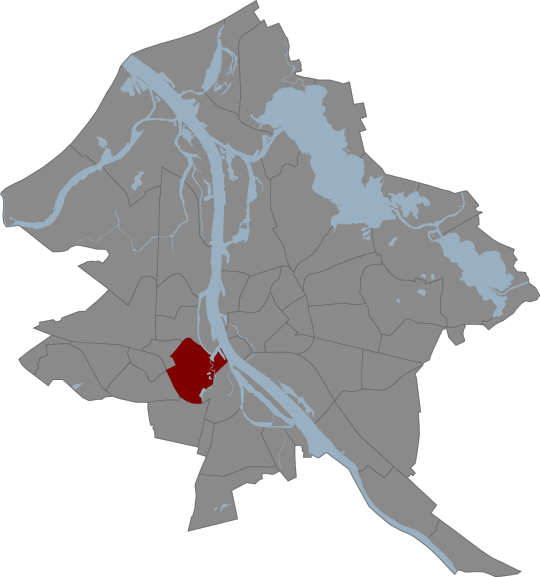
Name: Āgenskalns Meaning: Translates roughly to “Agens Hill” Area: 4.61 km2 (27th) 2014 Population: 27,923 (9th) 2008 Population density: 6538 people/km2 (11th) Distance from Riga Central Station by public transit: 8 minutes (train) Public transit lines: #3, #4, #4z, #6, #7, #8, #13, #20, #21, #25, #38, #39, #47, #50, #51, #52, and #55 busses; #1, #5, #9, #11, #13, #18, #22, and #23 trolleybusses; #2, #4, #5, and #10 trams Places of interest: Kalnciema Kvartāls, Uzvaras parks (Victory Park), Āgenskalna tirgus (market), Māras Dīķis, Alises torņis (water tower), Date of Visit: March 18, 2016
Last month we visited the cultural hub of the Pārdaugava region: Āgenskalns. One of the city’s most well-known and instantly recognizable areas, nearly anyone who has ever crossed the Daugava river to the city’s western half has been through at least a bit of the neighborhood, as two of the city’s four bridges cross into it. From Vecrīga, it’s just a five-minute walk across Akmens tilts (stone bridge).
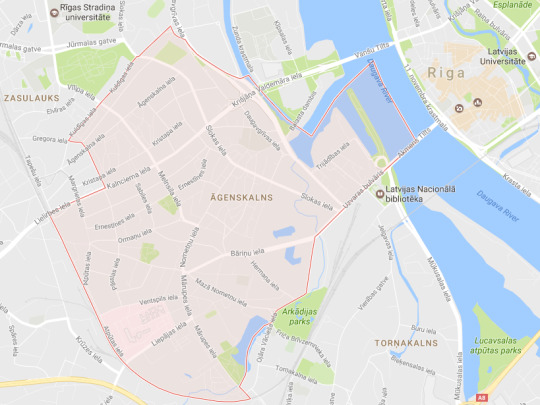
While the Rīga-Tukums line makes for a logical southwest border and the rivers clearly cut the neighborhood off from the rest of the city, the other borders seem a bit arbitrary and fuzzy. This is even more apparent when looking from above. Many people refer to a much greater area than just that in the red lines as “Āgenskalns,” while others might consider much of that northern area above Kalnciema iela part of of Zasulauks.
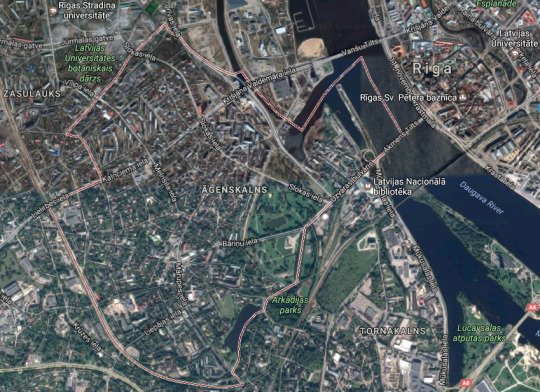
The good news was that we would be exploring Āgenskalns with our friend Konstantin, a life-long resident of Rīga with an encyclopedic knowledge of the history of the city’s buildings thanks to many hours spent researching online and in the city’s archives. Even better, he’s from the neighboring region of Zasulauks just to the northwest, so he was able to provide us with particularly generous wealth of information about Āgenskalns. The bad news was that the only day that him, Līga and I could all go together happened to be the one rainy day in a string of otherwise perfectly sunny and relatively warm days. While Konstantin’s philosophy was that this part of Rīga looks good even in gray and drizzly weather, I feel a bit bad that we weren’t able to do this beautiful neighborhood justice with such dreary backdrop.
Līga was a bit busy earlier in the day, so I met Konstantin by myself first to check out the area by the river before she would join up with us a bit later. I got on a #3 bus from the station and took it just two stops before getting off at the Nacionalā bibliotēka (national library) stop where I met up with Konstantin.

We started on towards the river, walking first by a beautiful pinkish pre-war building that Konstantin told us was used by the Soviet government as a teacher training academy. Apparently during Soviet times teachers were not required to have a university-level education, so it was something more akin to today’s trade schools. To the immediate left was what looked at first like a newly renovated pre-war building until Konstantin told me about the interesting history behind it. Apparently it was a derelict abandoned building before Latvia hosted the EU Council presidency back in early 2015. Since the library across the street was to be used to host dignitaries throughout the six months, the city ordered the owners to give the building a facelift, resulting in a freshly painted skeleton. I couldn’t believe this until we got closer and I was able to see inside for myself.
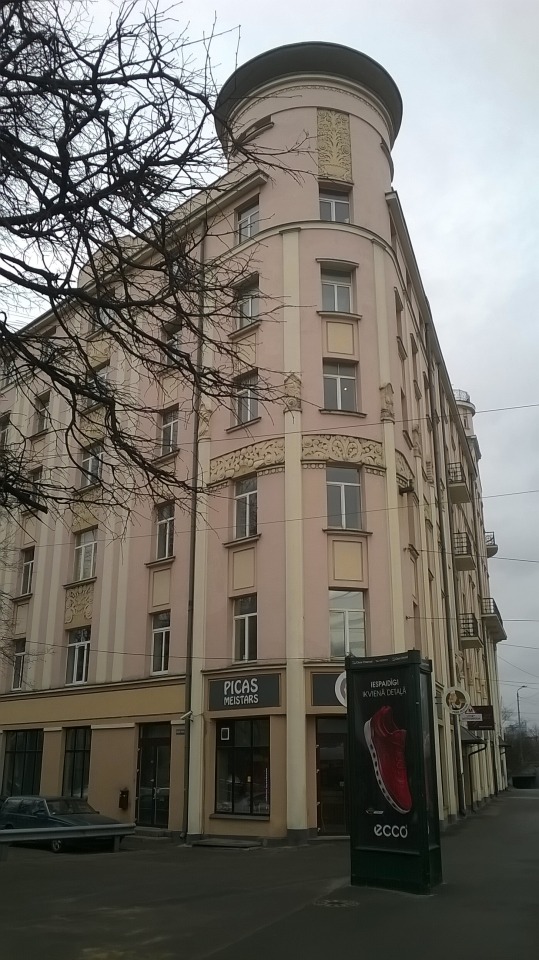


It’s inconceivable to me that this prime real estate so close to the river and tram lines had not been properly renovated by some savvy developer, but there are many other situations just like this throughout the city. Across the street was a somewhat unusually decorative Hruščovka with an interesting brick pattern. I might not have mentioned it previously, but one interesting thing about at least the brick version of these Soviet projects is that the year is usually inscribed at the top using differently colored bricks.

Continuing down the road, we came to an abandoned old police station across the street from a 90s-era housing construction. As is the problem with nearly any city in the world, it was sad to see such a beautiful structure fall into a state of disrepair which at this point would probably prevent it from being reconstructed in an economically efficient way. Its juxtaposition across from those modern condos were a bit poignant in illustrating how preservation can be lost as an urban priority.



Just a bit further on, we crossed onto the AB Dambis, a large jetty first constructed from wood in the 1880s to regulate the Daugava's flow and for loading and unloading boats. The structure was destroyed by the German army during WWII before being reconstructed in its current form by the Soviet army. If you're interested in learning more about it's history, you can check out this post from Cita Rīga (in Latvian, but can be translated). We walked out to the furthest point and took a few pictures of Vecrīga's skyline and of where we would soon be walking in Āgenskalns.
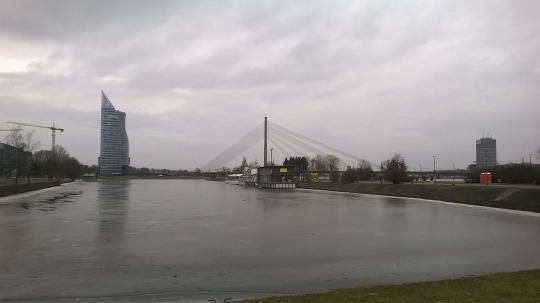



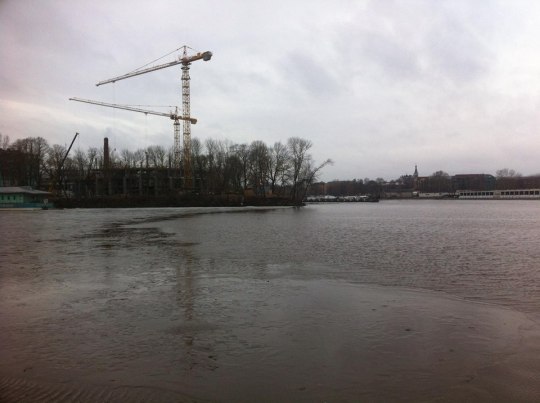
I got a call from Līga who said that she would meet us soon at the same libary bus stop where I had met Konstantin, so we started heading back in that direction. After waiting about ten minutes at the bus stop, we finally met up with Līga and started down the gray brick road of Valguna iela. To get there we passed under a concrete residential building which like a few others in the neighborhood had been constructed over the road itself. According to Konstantin, this was an “experimental” residential project which was not replicated due to its uncomfortably cramped living conditions and non-intuitive navigation on the inside. Along this road were a row of Stalin-era buildings on the left and some older wooden ones on the right.
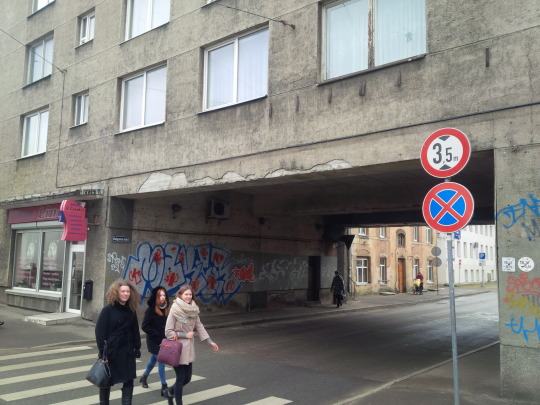
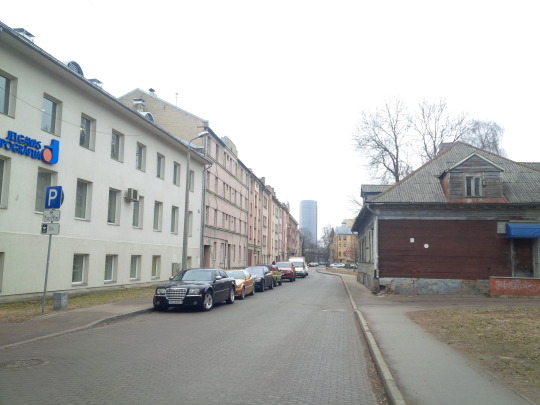
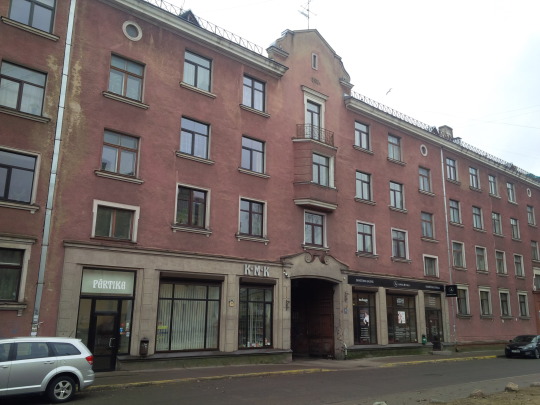
To our right there was a building which Konstantin pointed out was built on top of what had previously been part of Staraja Rusas iela, one of the only remaining streets in the city with a Russian name. While it's no longer officially part of that road (at least according to Google maps), it was interesting to see that some history-conscious person had written the name of the street above the driveway to preserve its memory. We also passed a what seemed to be somewhat nightmarish pre-school/kindergarten, along with a fairly scary balcony.
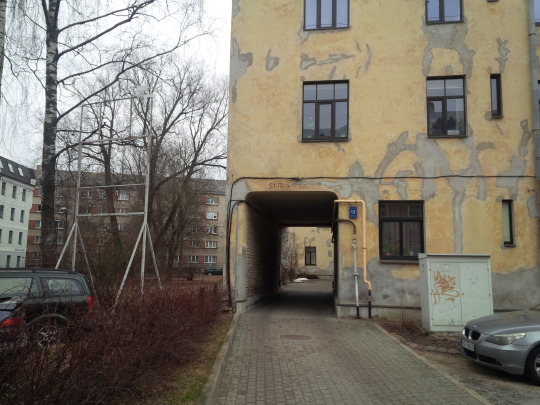


We came to the end of Valgumu iela, and before turning right onto Trijādības iela, we saw what Konstantin said had been a riverboat repair facility before being abandoned. We walked down Trijādības iela towards the river, seeing on our right a typical back yard with trees benches that are very commonly seen next to buildings built in the first half of the 20th century all the way up until the end of Stalin's time. A graffiti ghost on the wall seemed worried or upset about something; maybe we had gotten too close...



Unforunately we couldn't get any closer to the river since the construction area we had seen from AB Dambis was gated off, but Konstantin pointed out one very interesting building before we left. I wouldn't have noticed it on my own, but the two-story house was built in the traditional Latvian style that can be seen throughout the countryside, with the roof slanting on all four sides. Generally these houses are made of wood, so it was a bit unusual to see one here made of brick, further adding to my impression of Āgenskalns as one large architectural gallery. We passed by Latvia's sea administration and a modern apartment complex before coming again to the abandoned riverboat factory as well as a row of very typical brick hruščovkas and another scary-looking kindergarten.
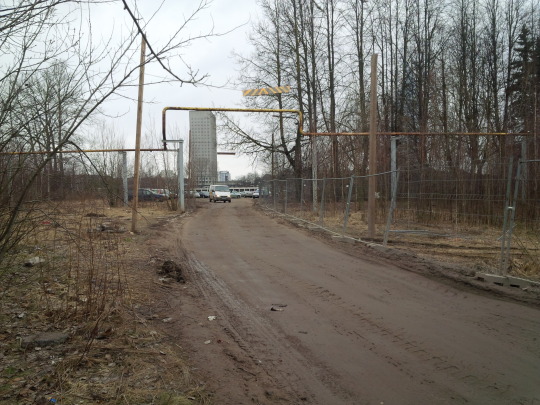



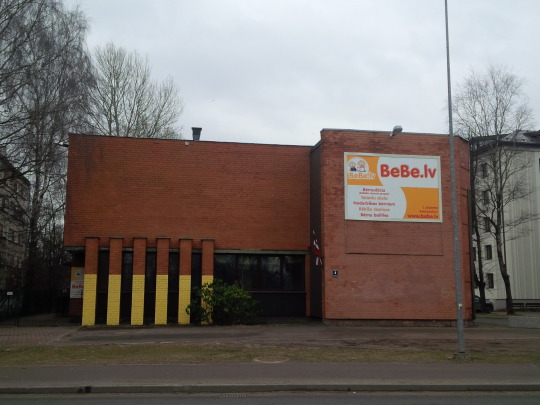
We took a right onto Raņķa dambis, which quickly turned into Daugavgrīvas iela. Although winter was more or less over, the cove of Zunds canal still had a thin layer of ice covering it. We got a good view of the old riverboat repair factory with some Latvian graffiti on the side and then saw some modern riverboats being repaired right in front of our eyes. Since there is no longer a dedicated facility, a man was standing on top doing some welding right in the open on the deck. We also passed my favorite place in Rīga to drink outisde during warm weather months, Piķis un Zēģele, a relatively cheap pub with a deck overlooking the water. If you're ever here in the summer months and love to sit back and relax outside with good, reasonably priced beer while watching boats go by, definitely check it out.
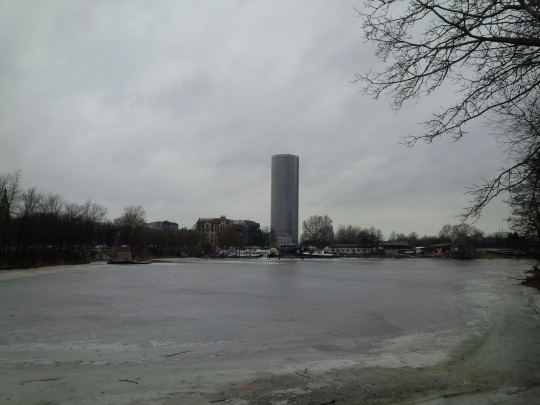


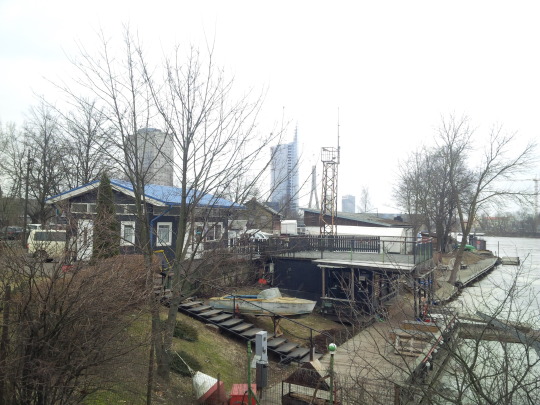
Just across Daugavgrīvas iela from the road to Ķīpsala, Konstantin pointed out a beautiful pre-war building which used to be a polyclinic for children and teens which unfortunately was now in such a state of disrepair that it had no floors. To the right was another beautiful pre-war building which was derelict aside from the first floor, this one having a commemorative plaque for Latvian composer Pēteris Barisons who had lived in the house before WWII. A brick hruščovka next door ws in much better condition, and had a variety of stores on the first floor including what looked like a tasty vegetarian restaurant.

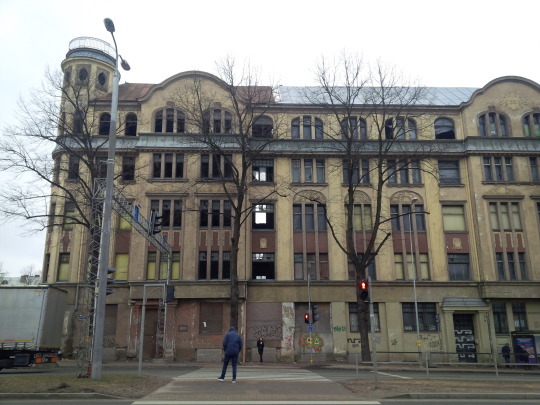
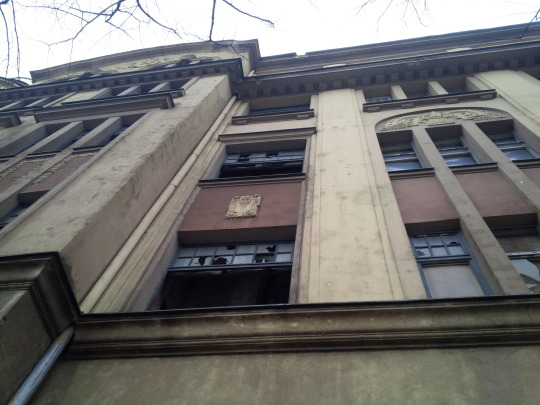
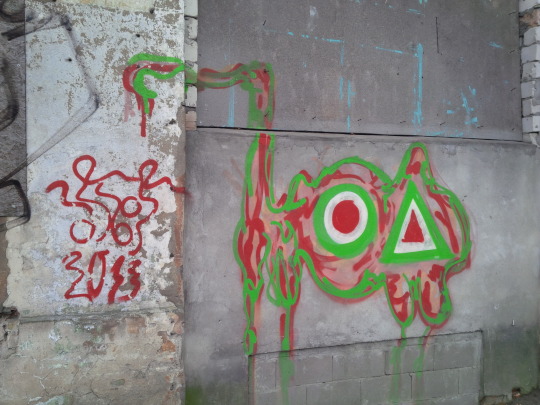

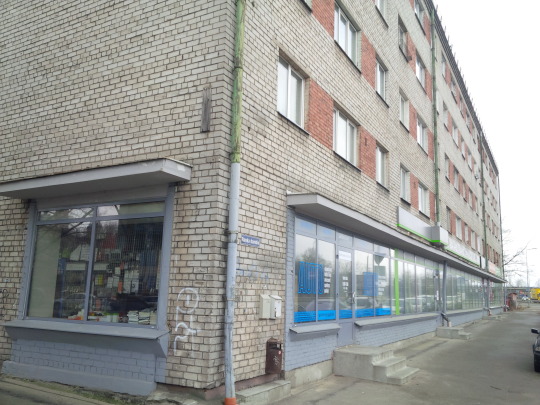

And now we were finally at the base of the infamous “Z-Towers” which had been visible from many previous neighborhoods. As I mentioned briefly in the article about Dzierciems, these troublesome twins had been under construction since 2006 and were conceived in a different era of urban planning just before the 2008 crisis where this area around Ķīpsala was planned to be a sort of financial district for the city and many other similar large buildings had been planned. As it is, it's almost a small miracle that these ones got finished at all. The buildings began sinking not long after construction since engineers had failed to compensate for the marshy ground beneath, and had to halt progress and improvise a new technique for drying out the foundation. The death of a construction worker whose harness tragically failed stopped progress for even longer, and the buildings went through multiple exterior and interior design revisions as it was being constructed to help make it more more economically feasible. As a result, the final minimalist and utterly generic result is a far-cry from the original gaudy and bombastic structure that was originally planned.
First planned to be an upscale hotel in one tower and offices in the other, now the majority of units in both towers have been marketed as luxury apartments of various sizes. Until 2014, it was possible to receive a five-year Latvian residence permit with full access to the EU and a path to citizenship for a property investment of as little as 70,000 Euros. Although parliament bumped that up to 250,000 Euro due to concerns about Latvia's property market being exploited as a massive money-laundering mechanism by international criminals, I'm sure that foreigners with an interest in accessing the European common market should have no problem finding a unit worth a quarter of a million in these glass behemoths. On one hand these towers further justify Āgenskalns' reputation as an architectural mecca, but at the same time even for this neighborhood they stick out like Siskel and Ebert's thumbs banged with a hammer by a bitter director. While it's easy to dismiss them as yet another tacky monument to the anonymous global 1%, I like to think of them as a relic from a more optimistic time in the city's history when the sky seemed the literal limit for ambitious developers just before it fell in spectacular fashion just a short time later. For more information about the history and future of this ongoing saga, check out this incredible thread on skyscrapercity.com which has been documenting the building's progress over the past ten years.
When we tried to get up close to the buildings, a security guard at the gate predictably banged on the glass and yelled at us to get lost. We were still able to get a nice look at the impressive structures as we hung left onto Krišjāņa Valdemāra iela and started up the hill towards the northern part of the neighborhood.

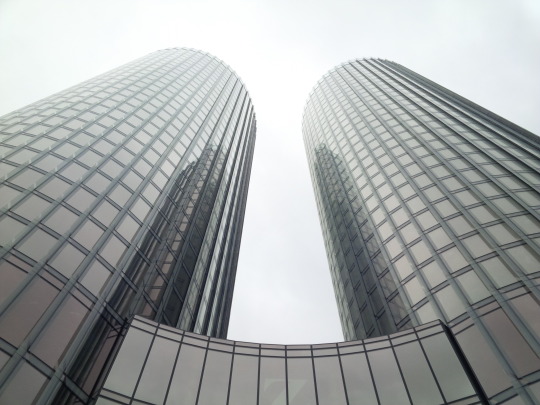
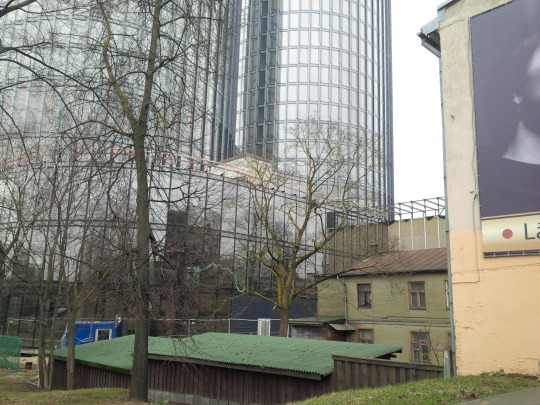
While the same can be observed in pretty much all of the city's more central neighborhoods, the clash between “old” and “new” is especially striking here. Aside from the obvious example of Z-Towers, this street was lined by a mix of small pre-war wooden houses, concrete and plaster early 20th century buildings, and glass and steel constructions which look like they had been dropped off by a visiting UFO.
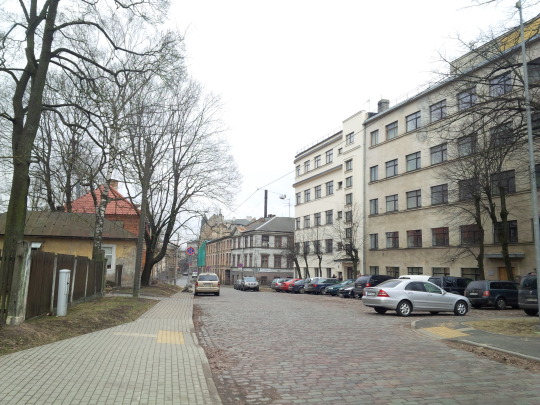


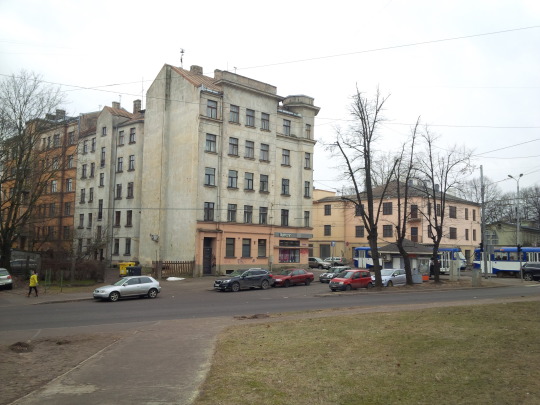

So far, this had been our route since we had met Līga near the library:

We now started down the major thoroughfare of Slokas iela, coming up close to one of Konstantin's and my favorite looking buildings in the city: the national historical archives. I'll let the pictures speak for themselves in terms of how awesome this building looks. The archives are free to browse, but professional photocopies to be brought home cost a fee. Luckily, scores of benevolent history fans have uploaded a lot of material contained there for free to various forums and websites. Much of the information contained there is in Russian due to that being the lingua franca and official language of the Soviet Union, so proficiency is required for serious browsing/research. Documents from 1920-40 though are mostly all in Latvian.
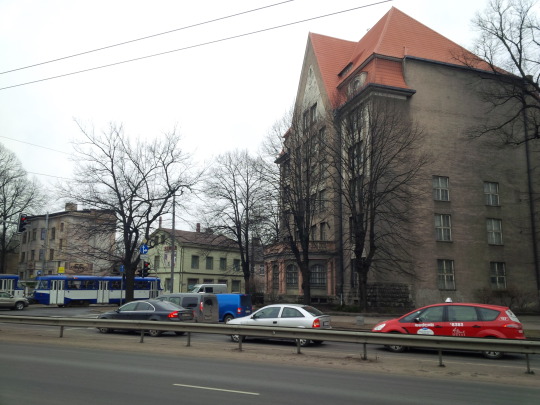
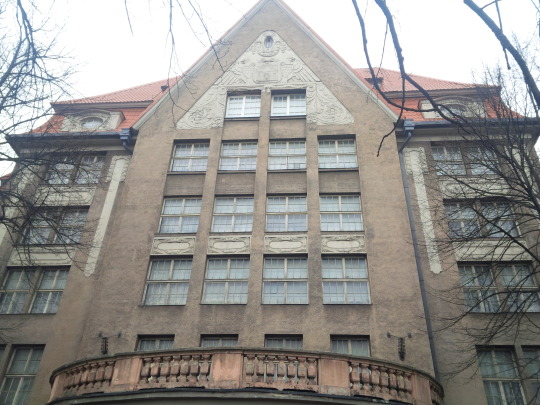

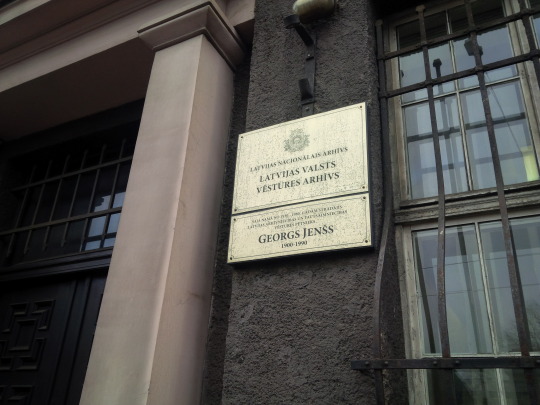

Slokas iela contained a nice mix of older wooden houses and Rīga's famous art nouveau buildings from the early 20th century. On one of the buildings, we found a subtle but interesting historical relic. During Soviet times, all of the street names were written in both Latvian and Russian throughout the city. After regaining independence, the government began replacing them with newer, Latvian-only plaques. On this particular building instead of replacing the entire sign, someone simply painted over the Russian version of the signage which had been found on the bottom of the sign. The result was surprisingly effective, as I never would have noticed if Konstantin hadn't pointed it out to me. We walked left down Mārtiņa iela and then left down the offshoot of Daugavgrīvas iela. No matter how far we walked away from them, Z-Towers loomed behind us.
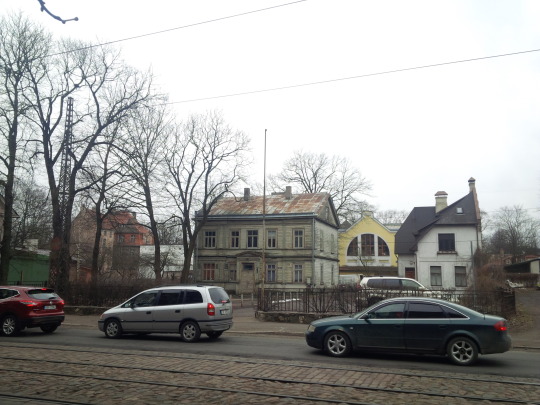
Jugenstils (art nouveau)
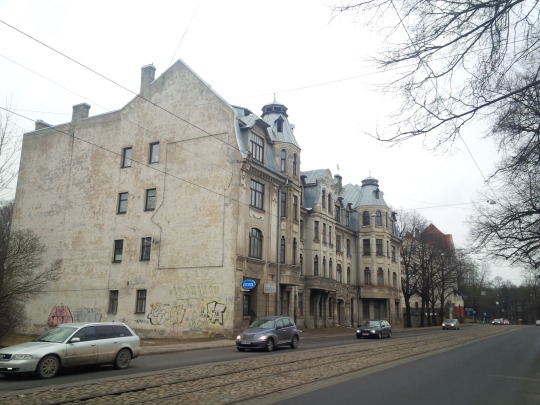

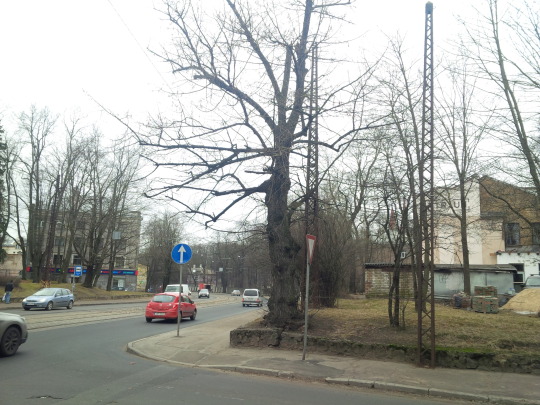
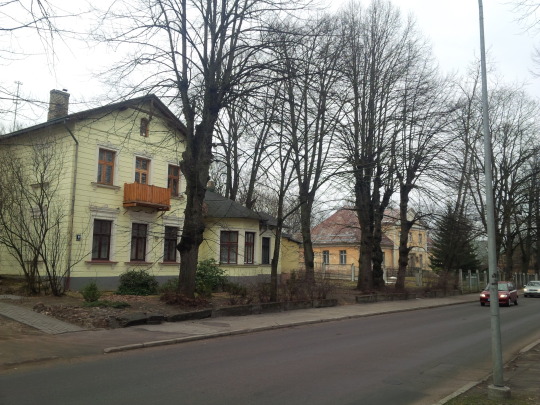

And now we came up to one of my many weird civil planning-related obsessions: a ghost ramp! These “roads to nowhere” are offshoots of other roads that are built to connect with a future transportation project that for one reason or another never quite materializes. This particular one was intended to connect with one of the many aforementioned projects intended for the Ķīpsala area before the bubble burst in 2008. If Z-Towers are a semi-living monument to the pre-crash era of naive optimism and big thinking, then this ramp is something like a poignant and symbolic memorial. I was excited to finally have an excuse to go onto this ramp that I had passed so many times before on my way to work, and from it we had a nice view of the tall buildings as well as the former territory of a factory that built farm machinery just underneath where the ramp is now. We also got a view of the northern edge of Āgenskalns where we were headed next.
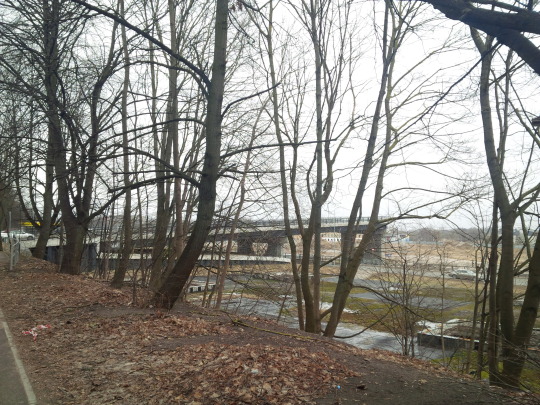
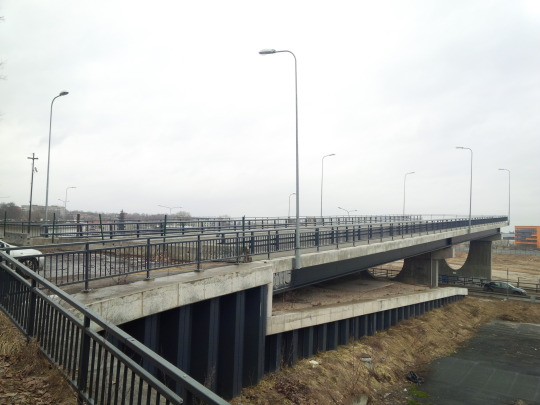
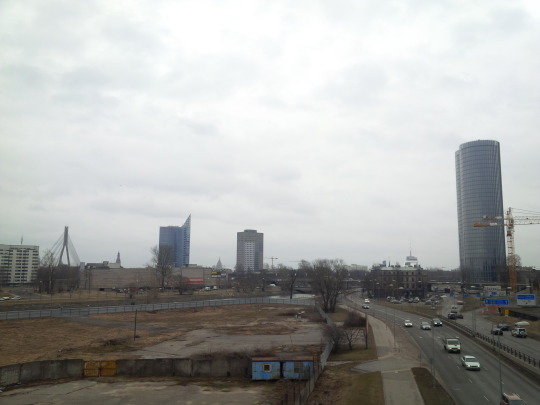

We walked towards Mārtiņa Evaņģēliski luteriskā baznīca (St. Martin's Church), passing two older art nouveau buildings: a current police station to the left, and an apartment complex with a classical-style sculpture out front to the right. When we got to the church's back yard, we took the path through crossing back to Slokas iela. The Romanesque church was built in 1851 and 1852, and the red twin steeples are visible from most of the northern part of the neighborhood. Konstantin pointed out the odd fact that the lantern is built in such a way that it can be lowered using a pulley.
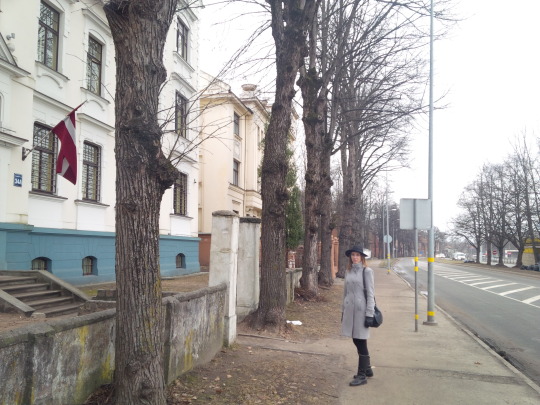
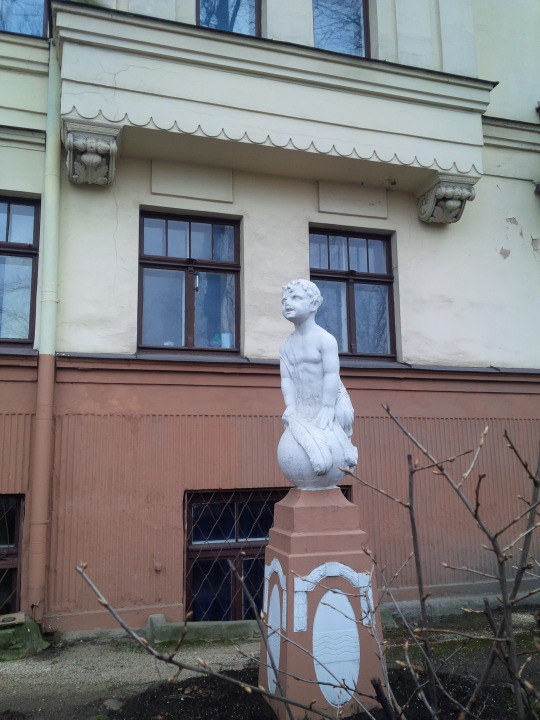
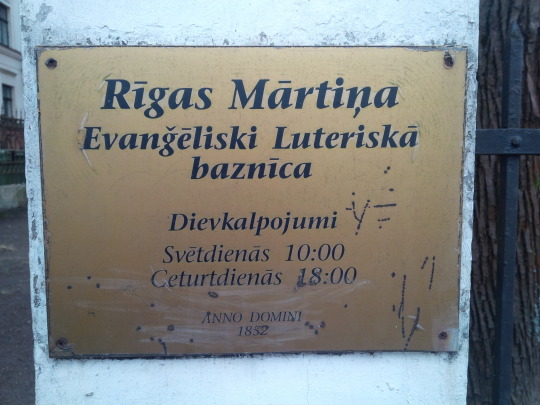
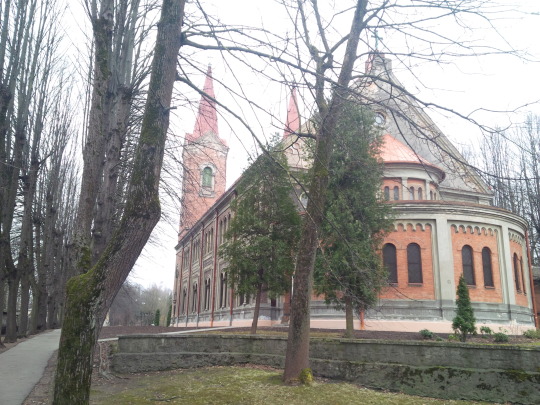

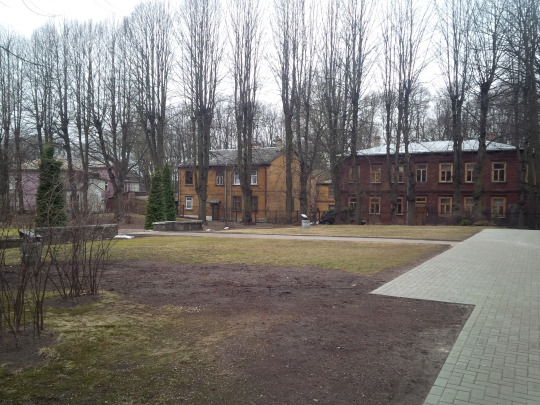
lowerable lamp

Coming out of the church yard and turning left onto Slokas iela, we passed a cool purple wooden building and a music school before coming to the nearly-abandoned Mārtiņa kapi (St. Martin's Cemetery). Many of those resting in this graveyard have no living relatives to maintain their graves, although we could see a few modern tombstones that distant descendants had bought for their long-departed ancestors. Following the tram line down the street we also passed the very modern purple courthouse before we turned right down Kuldīgas iela.
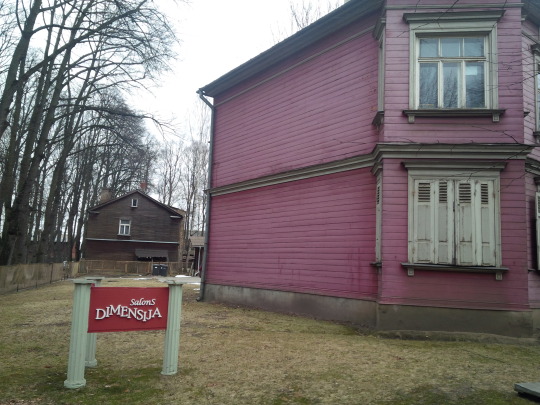

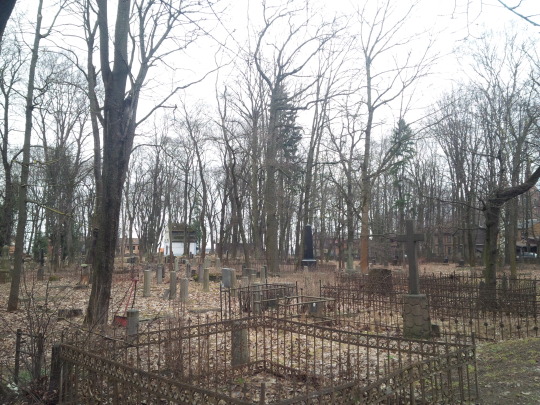
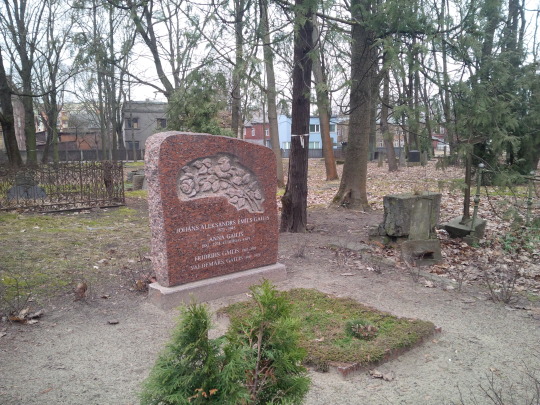


Just as we were turning left down Kuldīgas iela, we saw a plot of land adjacent to the botanical garden that seemed like it was part of the garden's territory until Konstantin explained that it was actually a private plot in the process of being sold. That explained why it had the old-fashioned wooden fence while the rest of the garden had a much newer metal one surrounding it. Signs of spring were everywhere as we continued down the street; people were raking up leftover leaves now that the snow had almost all melted, and small flowers were starting to bloom here and there. When we came to busy Vilpa iela, we turned left and came to Rīgas Valsts vācu ģimnāzija (State German Gymnasium), one of the city's oldest high schools founded in 1921. During months when leaves are on the trees, the school is hidden from the road except for the wooden “window” which you can see in the first picture of the school. Unfortunately, at this time of year the effect gets lost.
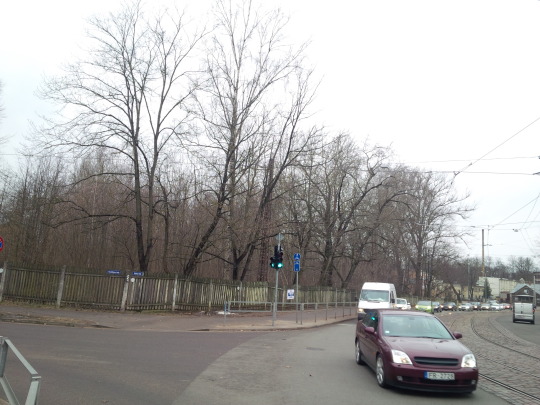
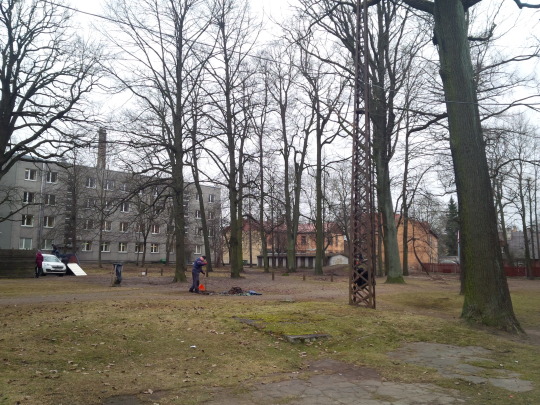
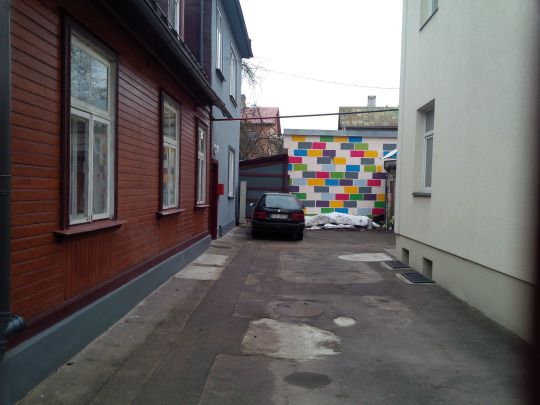
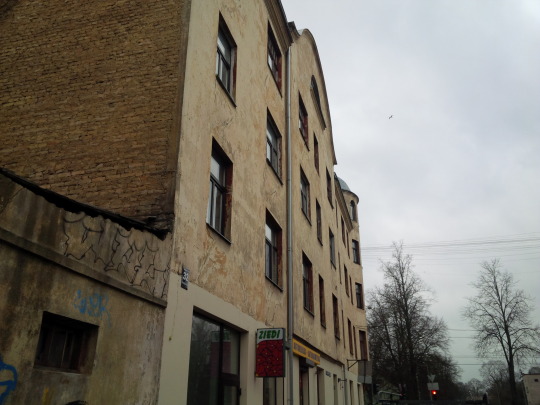
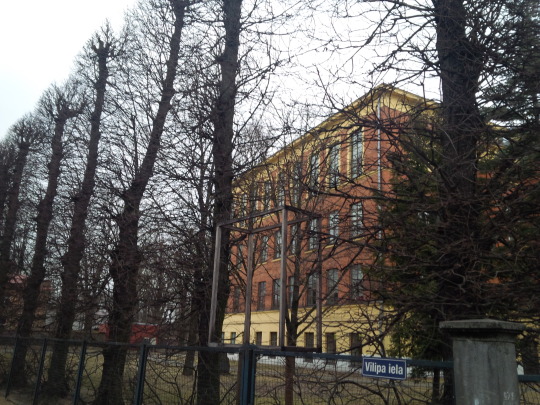
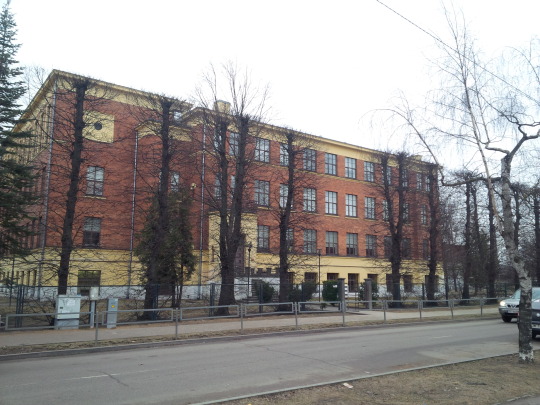
At the corner of Melnsila and Āgenskalna ielas, we found what Konstantin explained was called “Āgenskalna Priedes” (Agenskalns Pines). This early and experimental “micro-district” that the Soviets constructed in the late 1950s was the first of many often much larger projects in the further-out neighborhoods of the city which were constructed all the way through the 1980s. These concrete-panel buildings are some of the first very early hruščovkas to be built in the city in response to the post-war housing crisis that was only exacerbated by Stalin's obsession with ornate, decorative buildings which took too long to construct to meet the population's needs. Konstantin told us that while these buildings look to be in good condition from the outside, many have problems with electrical wiring beneath the floors that were not properly installed during the original construction.
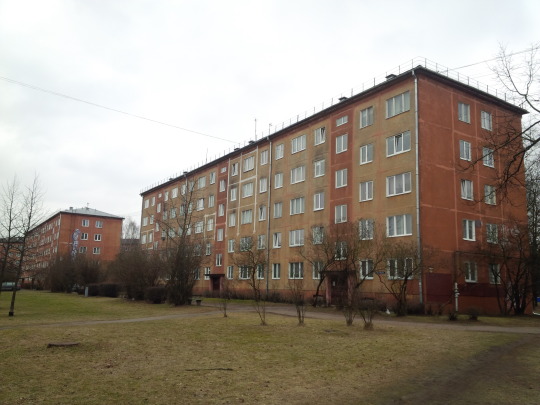



This housing project also has one of the last Soviet-era playgrounds to not be torn down to to safety concerns. The metal playground equipment you can see used to be ubiquitous throughout the city's suburban districts, but since independence the city has mostly favored removal over renovation. The building you can see in the background looks new, but is actually a recent renovation of a pre-war building. Seeing the potential of what could be if more of the city's gorgeous old structures received the same love and attention only makes it sadder to think about many of the other buildings' current states.
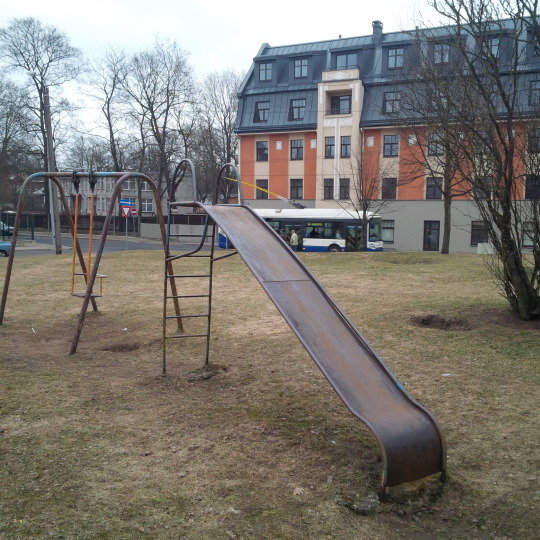
From the background of the development we could finally get a great view of one of the neighborhood's most famous landmarks: the water tower named “Alise” Yes, believe it or not, some of the city's gorgeous water towers have these kinds of names. After this particular one stopped being used for its original purpose due to introduction of more modern distribution methods, the building was used as an underground record label/studio until the late-2000s. The owner of the Coffee Tower chain and a few other bidders tried to buy it, but the city deemed it a historical monument before it could fall into private ownership. Hopeful the city will maintain and find a good municipal use for this beautiful landmark, as the building really is a stunning piece of architecture.
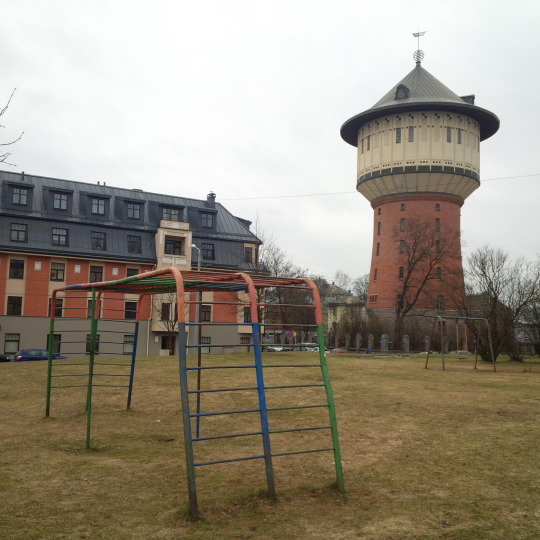

We turned back onto Melnsila iela and passed a wooden building with a store called “Alus pagrabiņš” (which translates to something like “Little Beer Basement”), a store which sells unusual and hard-to-find beers both on tap and in bottles. People often buy large plastic bottles of the beer straight from the tap so that they can bring it home and drink later, which is usually cheeper than buying glass bottles or cans.
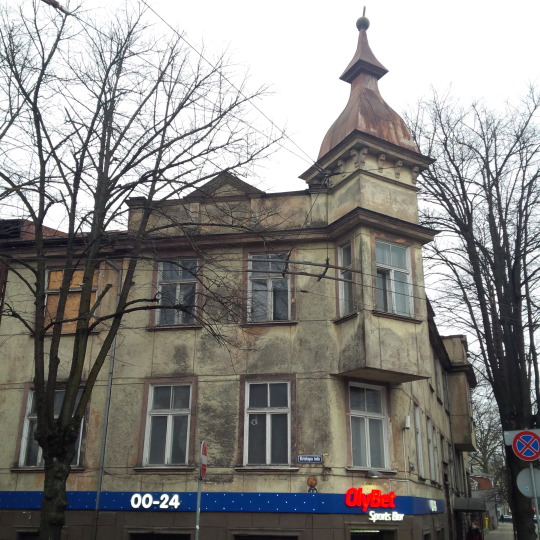

Now we came to the famous “Kalnviema kvartāls” (Kalnciema Quarter), a group of wooden buildings on the corner of Mensila and Kalnciema ielas. One of the most well-known enclaves of the city's “creative class,” the mini-district features various shops, galleries, offices, and performances spaces, and hosts many cultural events including a weekly Saturday market in the main yard between the buildings. We regretted not being able to come here a day later to check out the market, but I would strongly encourage visiting it if you can make it out here on a Saturday. For any of you who are fans of good wine, there's also a fantastic wine shop and cafe open every day except Sunday from 10-22.
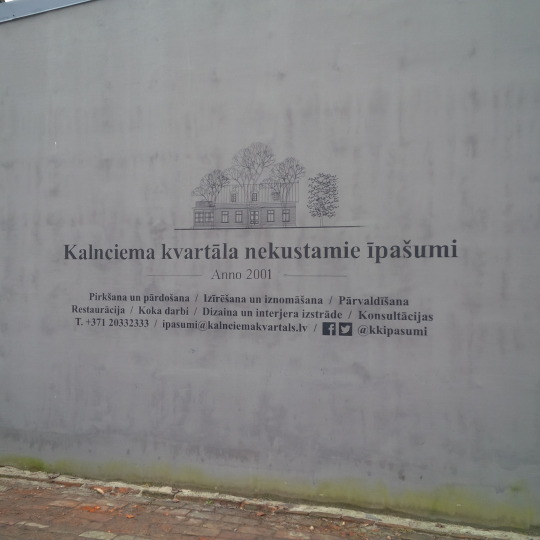
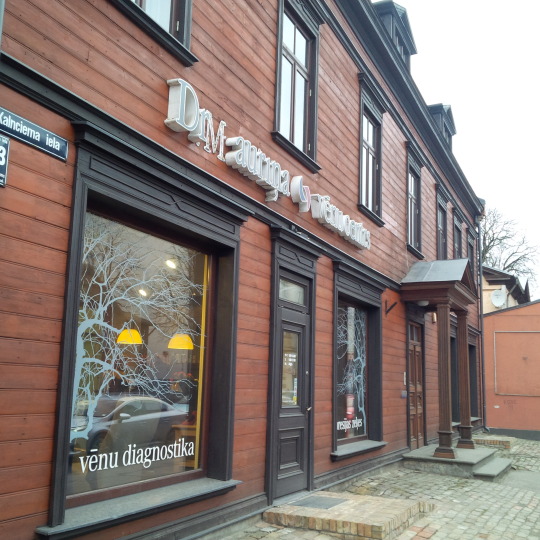

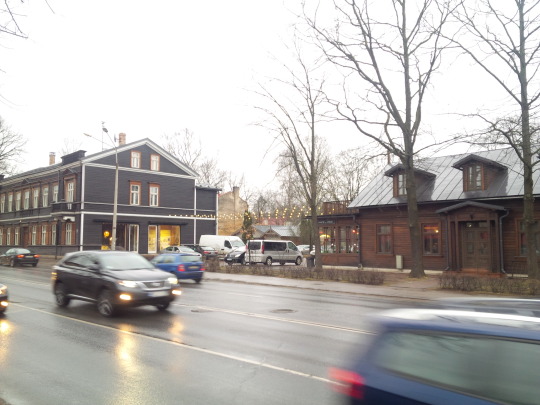
We were pretty hungry at this point, so Konstantin suggested that we try a kebab place called “Fix Box” which he had passed many times before but never actually tried. The interior was modern and colorful, and the prices seemed fairly reasonable so we decided to give it a shot. The wrap was toasted and crispy, which was a bit unusual for Riga's kebab places as they usually wrap them in softer shells. Overall the kebabs were pretty good, but I'm not sure it was mind-blowing enough to recommend coming all the way from the center for considering the wealth of options there to try. If you're in the area and love kebabs though, I doubt you'll be disappointed.
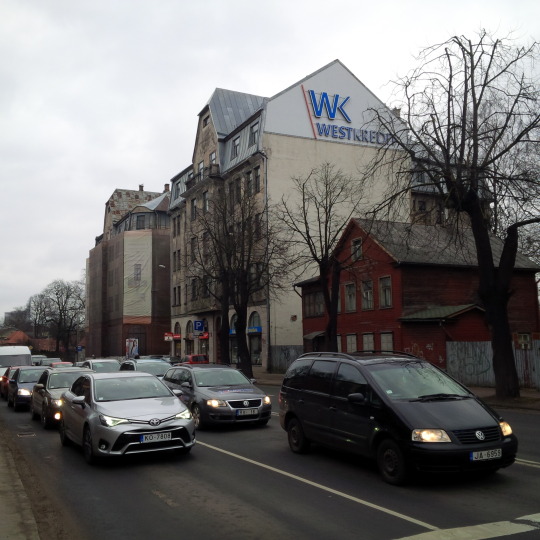

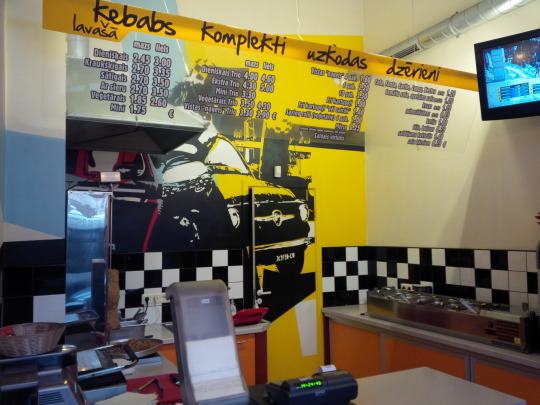

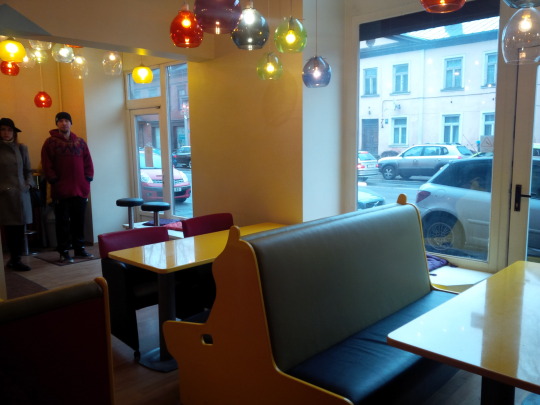

Since the ghost ramp, here is more or less the path that we had taken to the kebab spot:
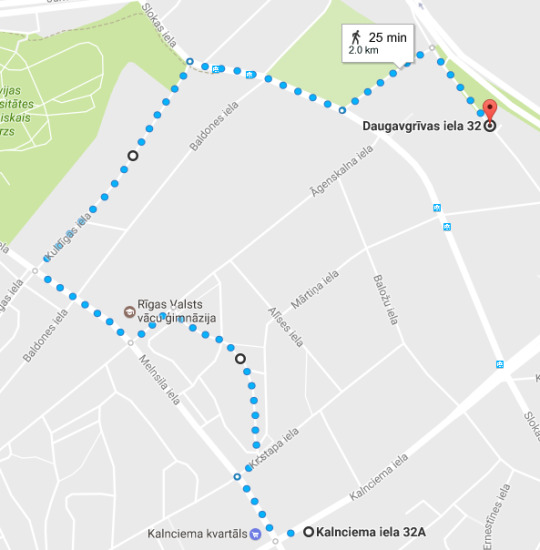
As we left our lunch place, the weather began to take a turn for the worse that would gradually only worsen. Undeterred, we continued southwest down Kalnciema iela before hanging right onto Sabiles iela. Down this street the mishmash of modern and older architectural styles continued, although in this part of Āgenskalns most all of the buildings didn't reach more than three stories tall. Konstantin pointed out that the dilapidated green building at the end of the road had been “somewhat renovated” on the very right side, which is not uncommon for some of Riga's older buildings in such condition considering that many such buildings have multiple owners. A lot of the older wooden houses throughout the city are split into halves or even quarters depending on the size, and this can be reflected sometimes in the buildings' visual appearance.
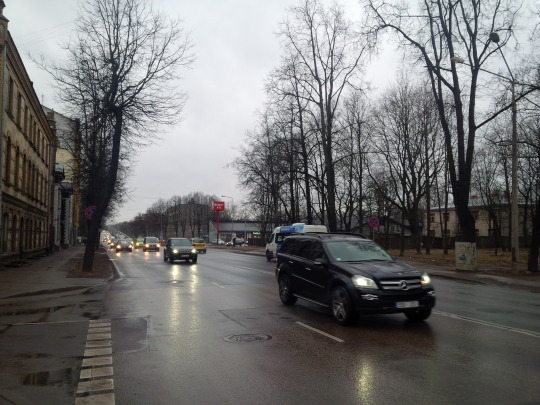
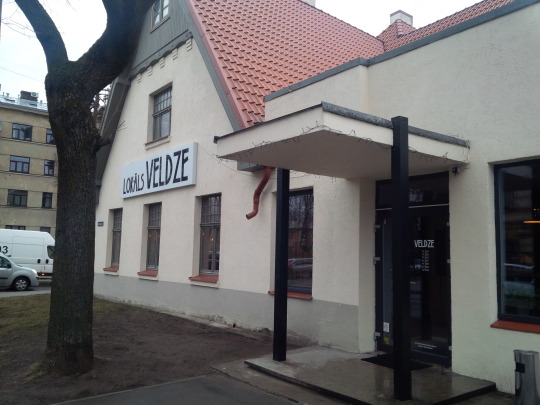


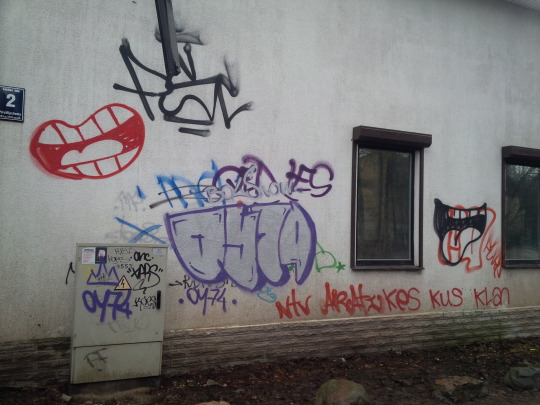

At this point, Sabiles iela turned into Talsu iela, and we continued on towards the more urban part of Āgenskalns. Right at the start of Talsu iela I saw one of the coolest yet strangest-looking houses I've ever seen, which seemed as if the architect was torn between three different styles and chose all three. A bit further down the road, we got a glimpse at the old TV tower. Before moving to is current headquarters on Lucavsala in the middle of the Daugava, Latvia's Television used to be headquartered in Āgenskalns, and used this tower to broadcast. According to Konstantin, the city has deemed the tower as a “dangerous object” and has ordered it to be repaired immediately. Regardless of its perilous state of repair, the tower still currently broadcasts Radio Merkurs on 1485 kHz (AM).


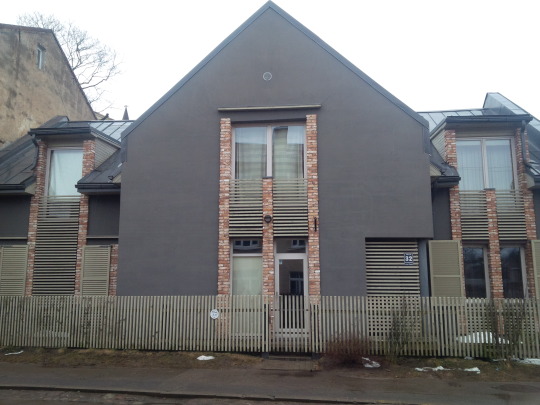


We turned now left onto Nometņu iela since Konstantin wanted to show us a few different buildings this way. We found a sad wall that was either bemoaning street litter or had very low self esteem. A bit further down we came to the first of the buildings that Konstantin had mentioned, a “communebar” called “Hāgenskalna Komūna.” He told us that it's the best place this side of the river to hear small acoustic concerts, although various DJs also play sets. Apparently they also offer a good selection of food and drinks, so we plan to check it out sometime soon.
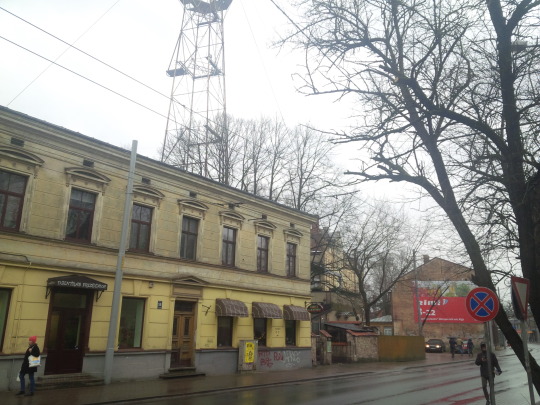
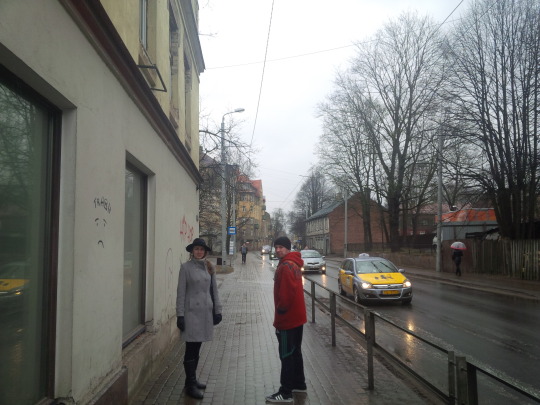

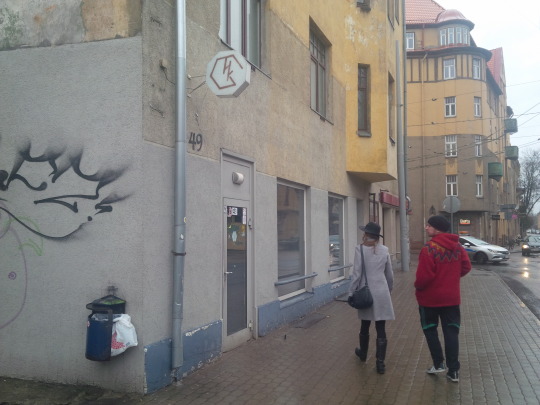

Just past the corner of Lapu and Nomeņtu ielas we came across the scariest-looking balconies on the planet, which were all missing floors. They were (barely) attached to one of the coolest-looking buildings in the entire neighborhood, a strange castle-shaped one over which there is a dispute as to which architect designed it. Apparently two people claimed to have drawn the original design. Next we found what is a very popular trend in America but something I had so far yet to have seen in Latvia: former cinemas converted into evangelical churches. The first was a brown Art Deco-ish one on the left which now hosts the “Dzīvā Ūdens Avots” (living water source) Pentecostal Church, and the second was a tan-colored one just down the street which is inhabited by the “Jēzus ir Kungs” (Jesus is Lord) evangelical church. The second was offering an “alpha course,” a basic introduction to Christianity that was popularized in the UK but can now be found all over the world.
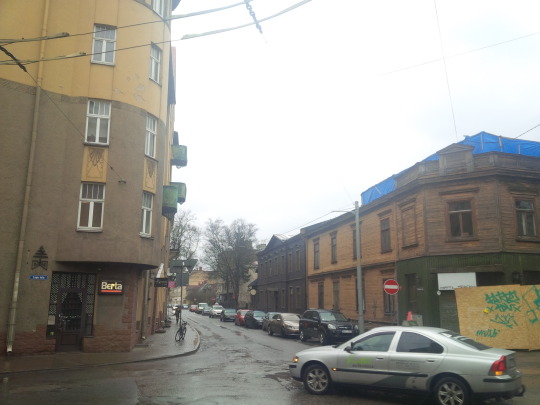
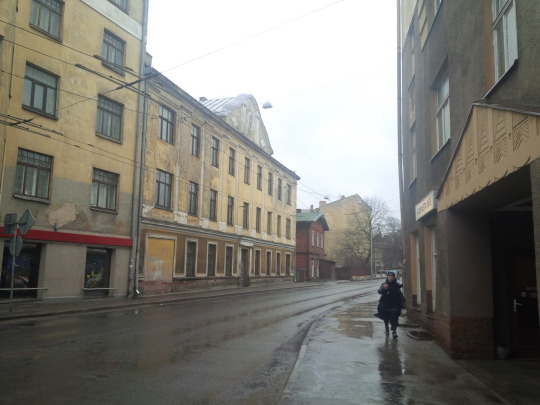
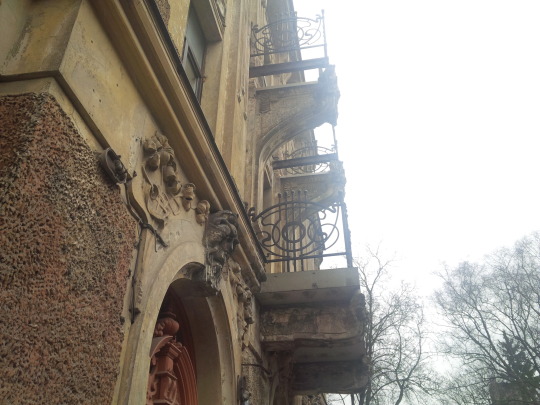
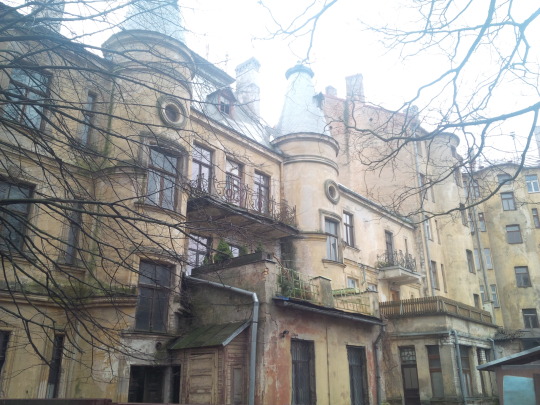
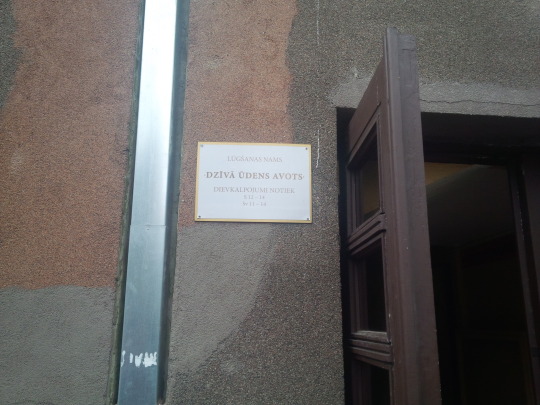
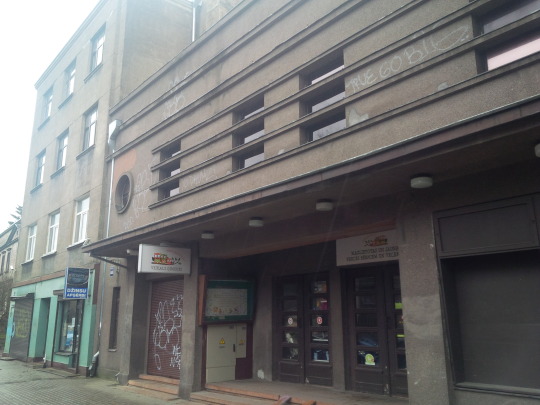


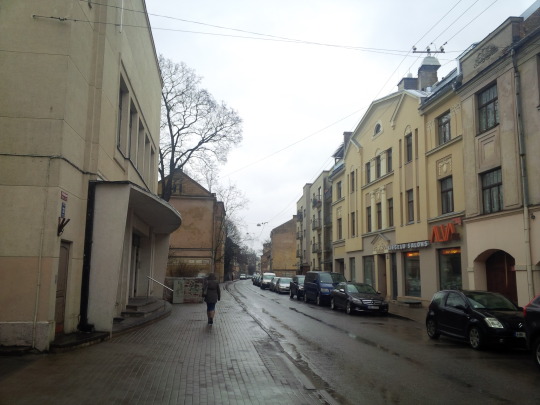
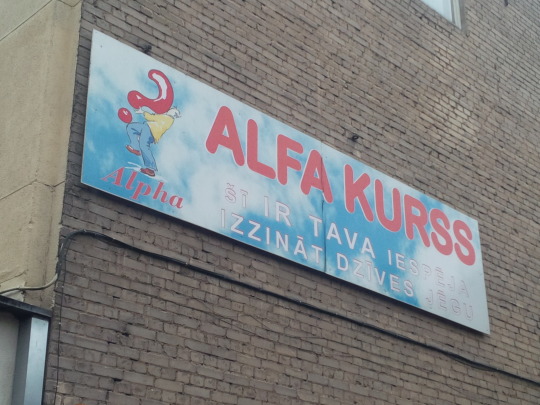
Continuing down the street, we saw more wooden and brick buildings from various eras. Shops included a fancy-sounding “brick salon” (yes, a salon in which you buy bricks), a door and window ship, a pizza place, an upscale restaurant, an antique shop, and another location of one of Līga and my favorite cafes in the city: Ciemakuklis, which we visited in Dzirciems last year. At the intersection with Slokas iela we took a left.
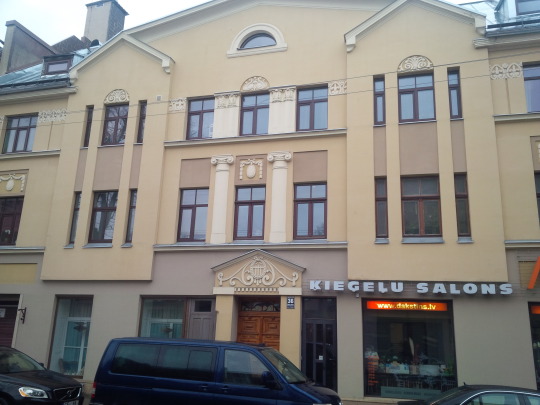
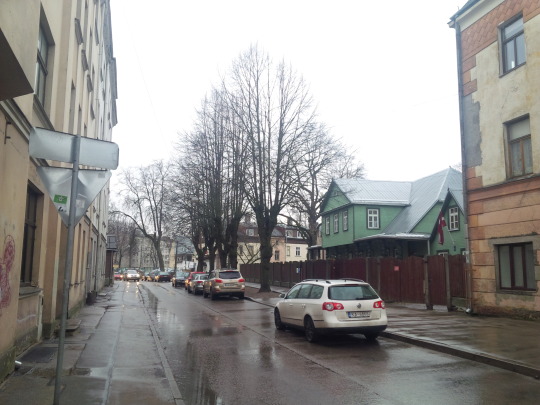

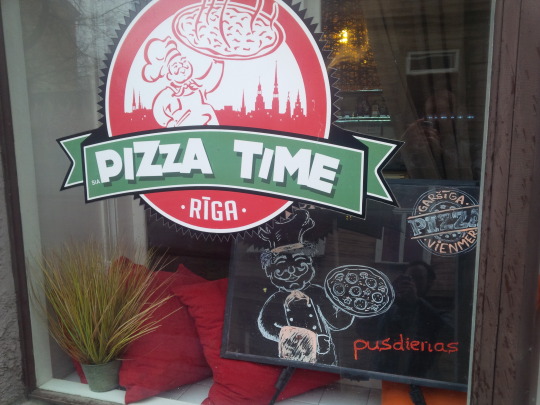

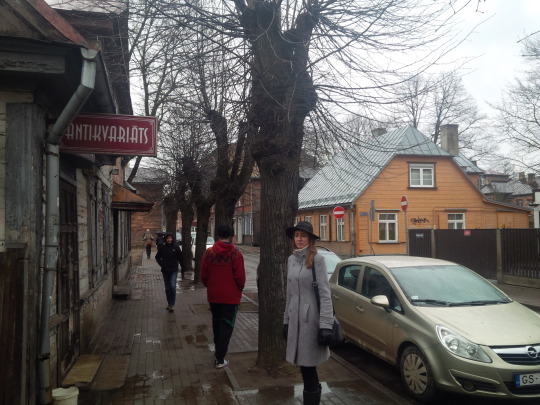
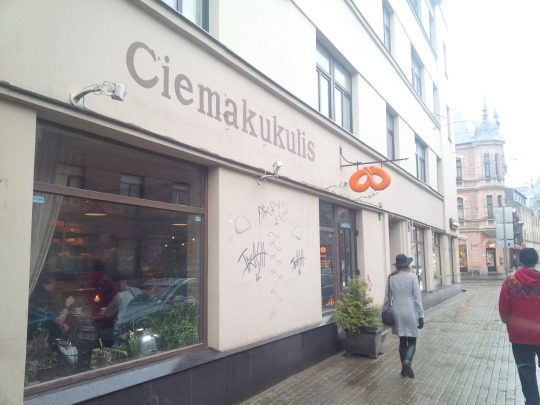
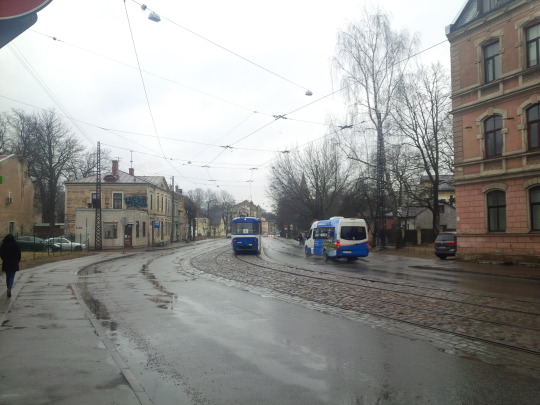
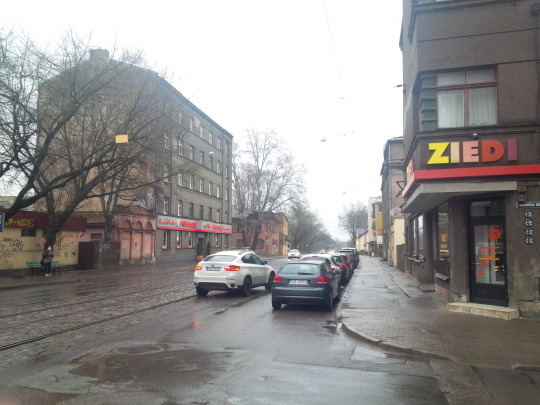
On Slokas iela, Z-Towers once again reappeared and loomed in the distance. We walked first by a church called Latvijas apvienotā metodistu baznīca (Latvian United Methodist Church), one of the few methodist churches in the country. Next door was an old white building which Konstantin said used to be used as a wedding registry. He told us that his parents had registered their marriage there, and that they were sad to see it become derelict throughout the years. We were just about at the corner of Slokas and Kalnciema iela again where the state archive was, so we took a few pictures and then hung left down Ernestīnes iela back towards the market square.

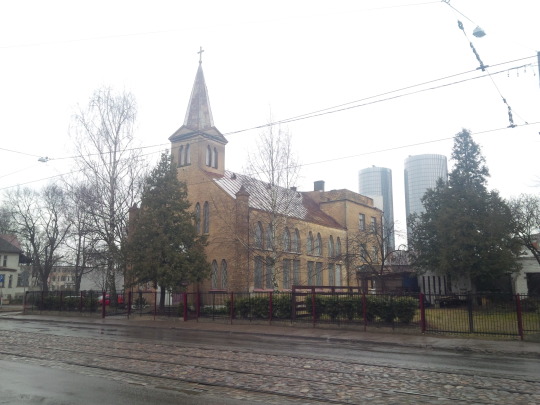


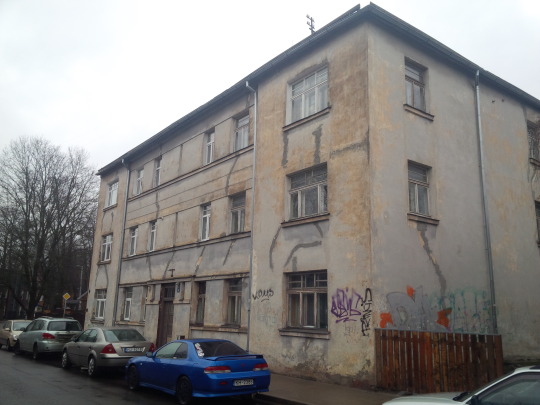
Ernistines iela cut through yet another district of short, wooden houses, but this part of town contained some of the city's most well-known schools. The first was Rīgas Dabaszinību skola (Riga School of Natural Science), a UNESCO-affiliated youth education center that puts on various workshops and activities related to natural science. The gate looked open and we wanted to take a look through the school's grounds, but we opted against it. Across the street was the well-regarded Āgenskalna Valsts ģimnāzija (Agenskalns State Gymnasium), a high school that is consistently ranked in the country's top five in terms of exam results and student achievement. The third we passed was the newly renovated Rīgas 53. vidusskola right on the corner of Ernestine and Melnsila ielas.


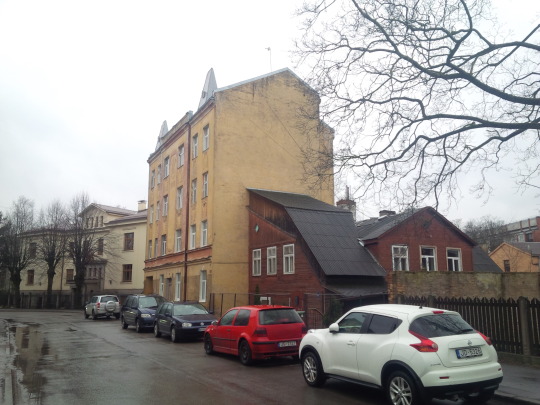
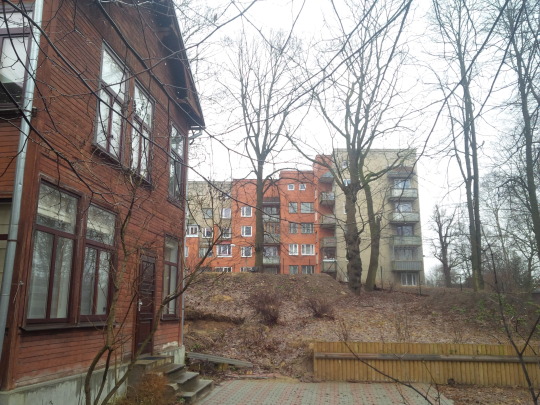
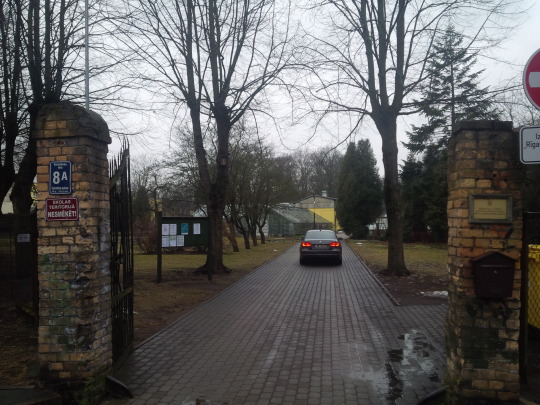
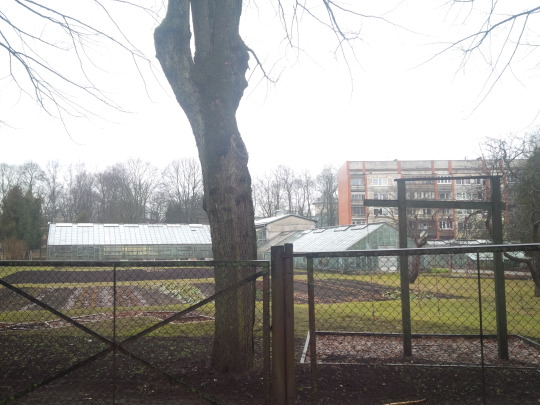
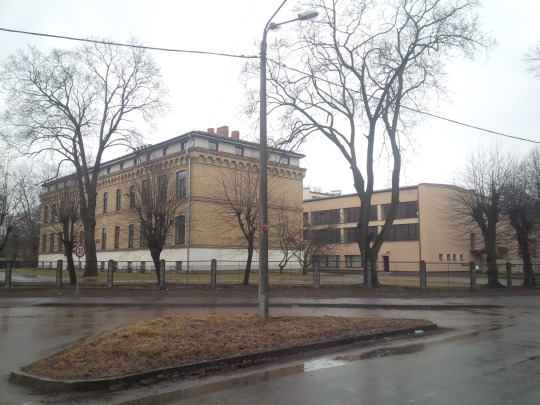


As we turned left back onto the larger road, we saw a car driving by with some large metal piping tied dubiously onto the roof. This reminded me of how in my home state of Maine it’s not uncommon to see pickup trucks on the highway with large stacks of various items tied precariously onto the bed, and how its occasionally necessary to dodge them when they fall out onto the road in front of you. We followed Melnsila diela back down to Nometņu iela where we took a right and started heading toward the market.
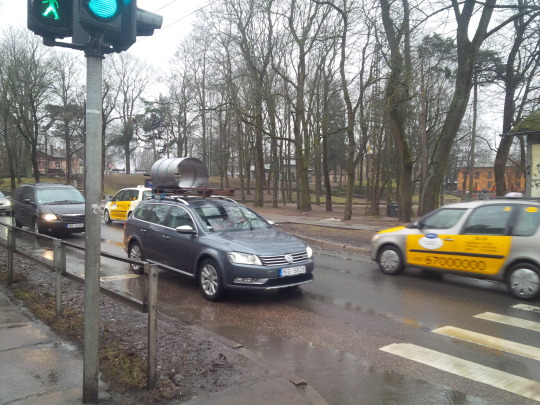
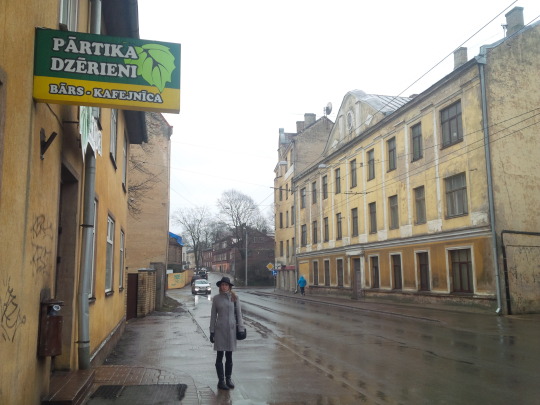
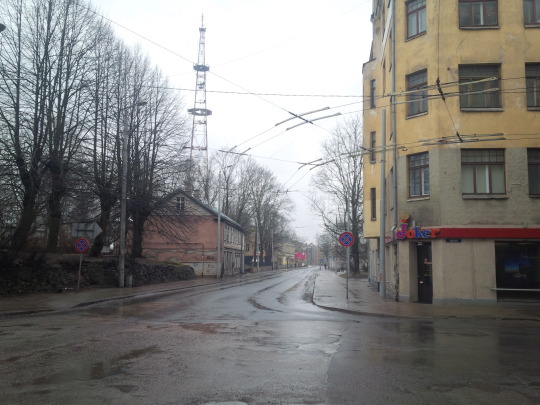
Since leaving the kebab spot, we had walked in this very strange spiral-shaped path:

On our way to the market we passed by one of the city's rare food trucks as well as two cafes situated next to the old tower. It's a bit hard to see from the picture, but one of the tower's supporting guy wires had been decorated with colorful ropes. Konstantin told us that the SEB building (one of Latvia's most popular banks) used to be taller, but that the top floor had been removed during renovation to help make the building more sturdy.
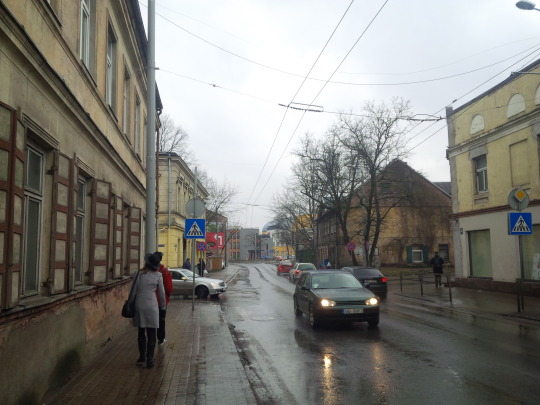

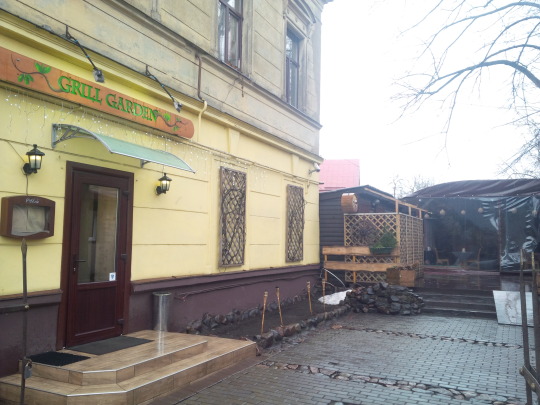
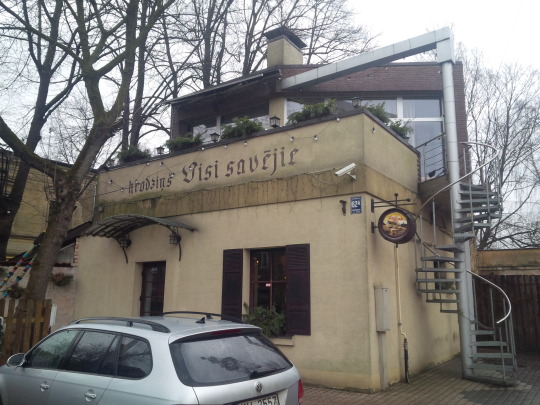

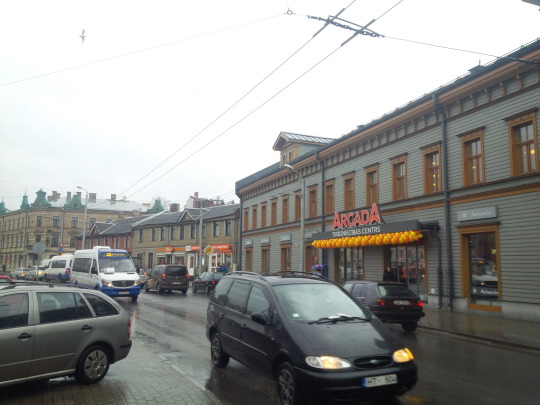
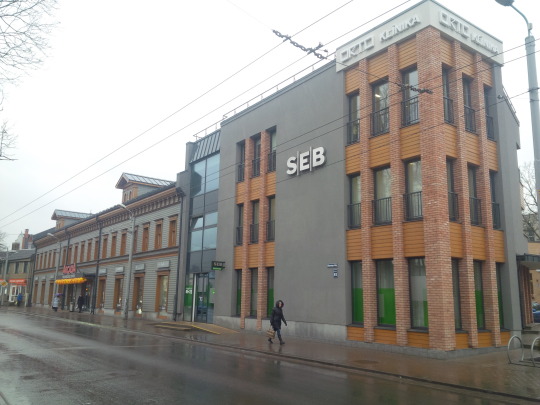
In the market square there were a bunch of posters for a theater event called “Obama Bananas Go,” which according to one of my friends was some sort of abstract high-concept comedy show that had nothing whatsoever to do with former President Obama. While I was shocked at first and am sure that the poster would have not only been taken down within hours but also sparked outrage if it were posted in the United States, Latvia has so few people of color that conversations about race are nearly non-existent and some of my students even have a hard time understanding why they can't use the n-word even though they hear it often in rap music. That doesn't stop me from trying to educate my students about these issues as much as possible and doing my small part in improving this situation, but I'm not as shocked by this sort of thing as much as I was when I first came here.
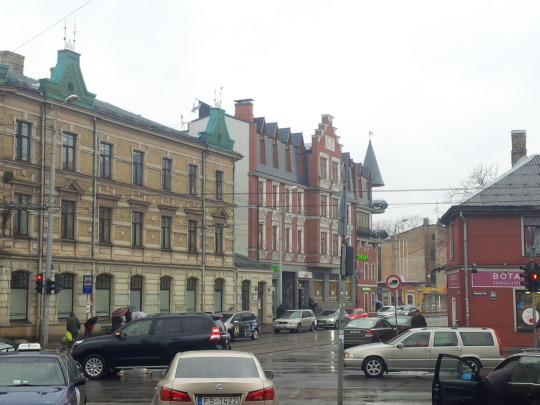
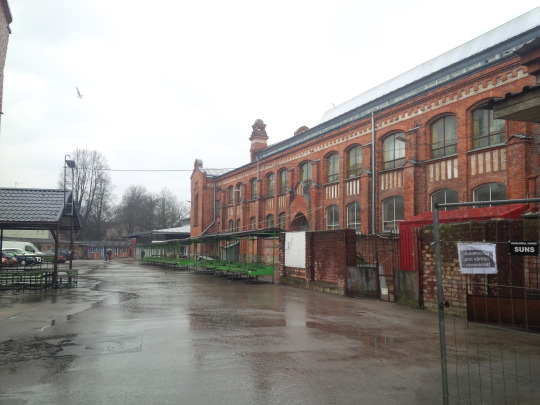
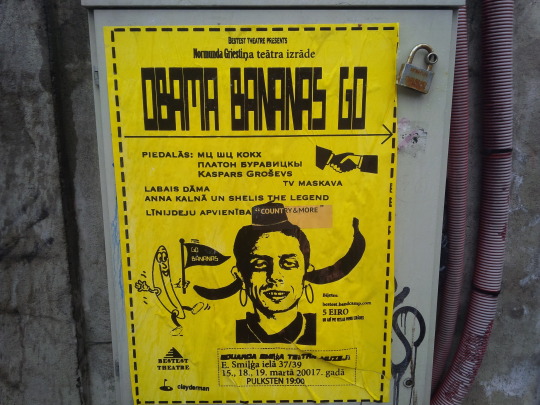
This “trash” frowny face was even sadder than the last one.
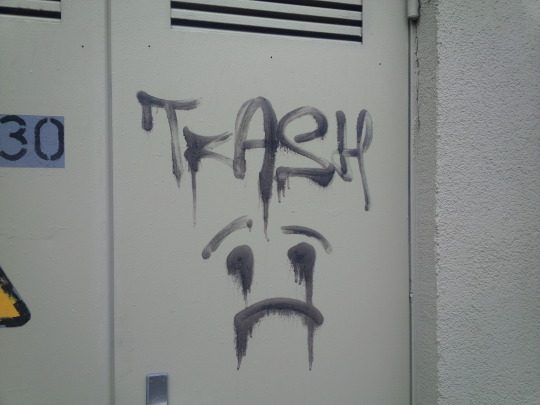
The interior of the market building was fairly typical for this region of Europe, but Konstantin told me that he much preferred this one to the more famous and impressive central market in Rīga's center due to its more intimate feel. The walls above the market stands were adorned with the coats of arms of Latvia's cities and towns, which was a nice touch. Luckily the upstairs balcony was open and we were able to get a nice view of the whole inside. There were some very nice looking meats, fruits, and vegetables, but we still had a lot to see and decided that carrying around perishables probably was not the best idea.


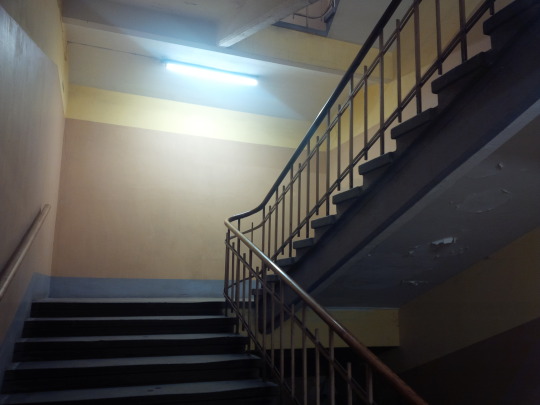
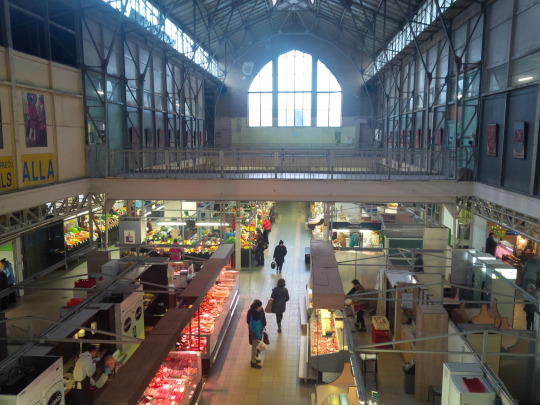
The stands and benches outside were emptier than usual due to the weather, but there were still a few people selling fresh flowers to passers-by. We continued a tiny bit further down Bāriņu iela to one location I had passed by many times but had never been able to get a closer look at: the Eduarda Smiļģa Teātra muzejs, the city's museum of theater. This former home of famed actor and director Eduards Smiļģis (1886-1966) is now run by the Latvian Academy of Culture as a space for exhibitions and live shows. The grounds of the building were gorgeous, but unfortunately we decided that we would have to save the museum itself for another day considering how wet we now were and how little time we had left to see the rest of the neighborhood.
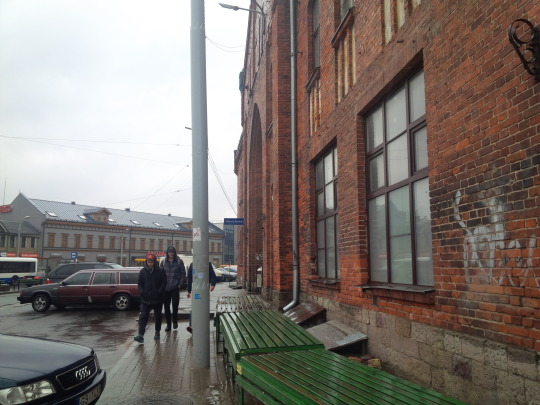

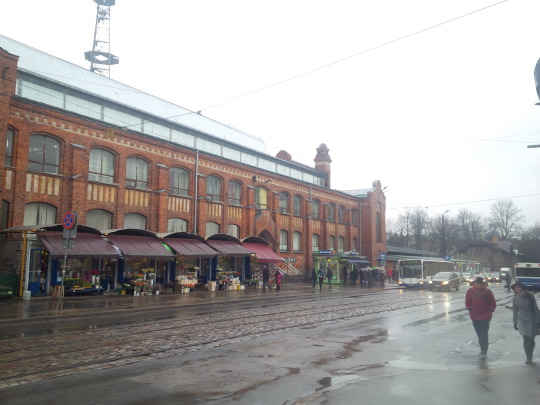
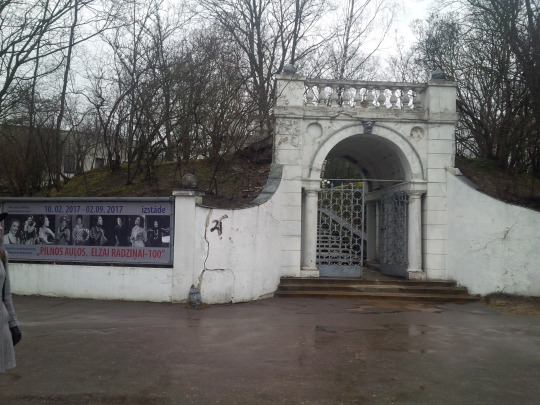
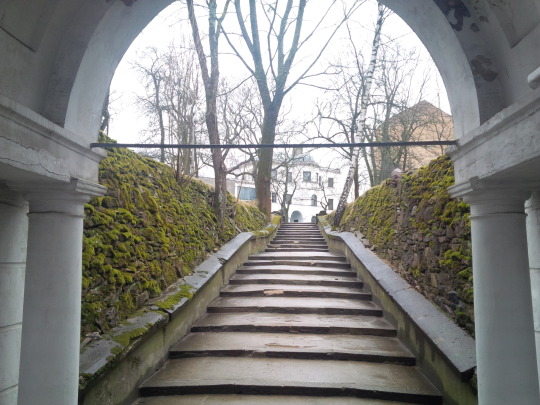



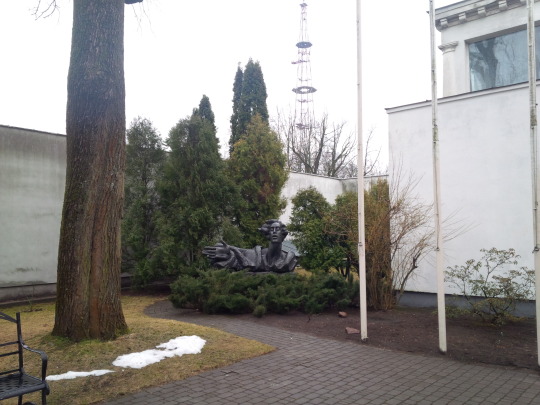
Līga wanted to see Svētā Alberta (St. Albert's), one of her favorite churches, so we headed towards it via a roundabout route past Māras diķis (Mara's pond). We started past the beautifully painted Rīgas Friča Brīvzemnieka pamatskola, one of the city's most historic elementary schools. The far less attractive concrete box across the street was Rīgas Pārdaugavas izpilddirekcija, home to a variety of government services available to those living on this side of the river. This style of building which looks brutalist to American or British eyes is incredibly common throughout the former Soviet Union for various municipal or education-related institutions. As we got closer to the park, we passed a few more wooden and brick buildings built before WWII as well as a few very modern constructions.

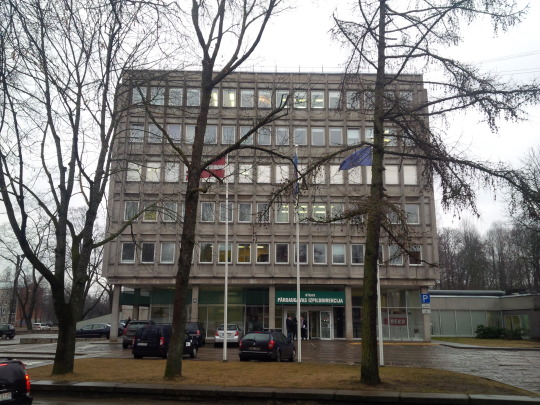


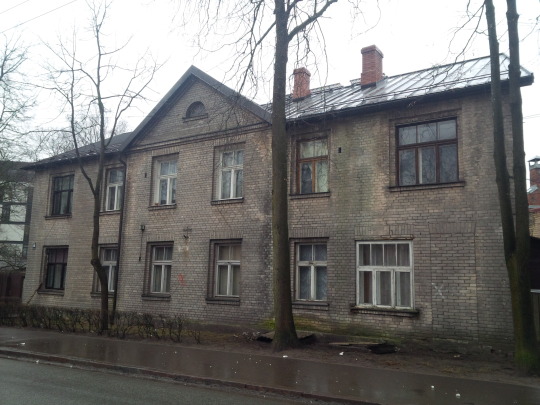


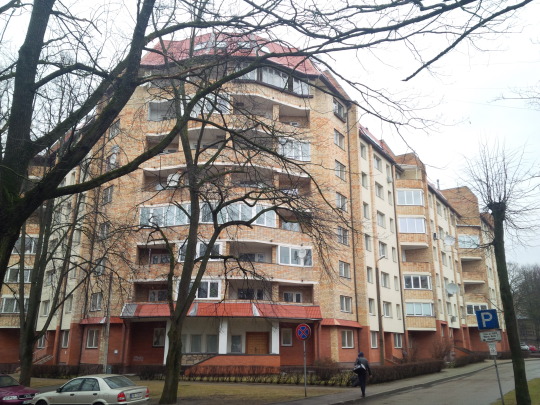
Right near the pond there was a small park with a hill formed from a split between Kokles iela and Mazā Nometņu iela. There wasn't any information that we could find about it, but it seemed like a natural extension of Arkādijas parks in Torņakalns on the other side of the road. The park seemed pretty well-maintained, and at the top of the hill there was a decent view of the surrounding area including the pond.





As you can see from the last picture, Māras diķis is lined on its eastern coast by a walled-off mansions. Thankfully, the entire circumference of the pond is accessible via a paved walking trail. The pond was used for mills all the way back to the 13th century, although the most recent mill was torn down in the 1920s. These days it's only used for recreational purposes, but no swimming is allowed.

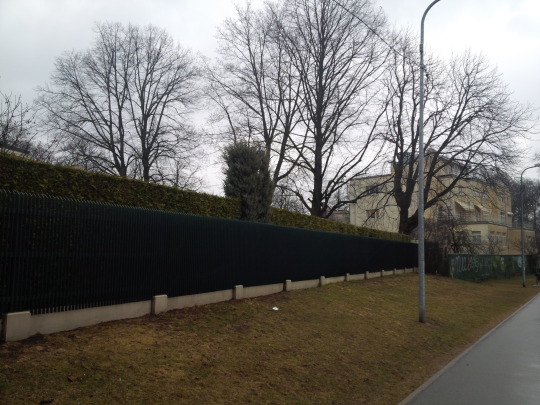
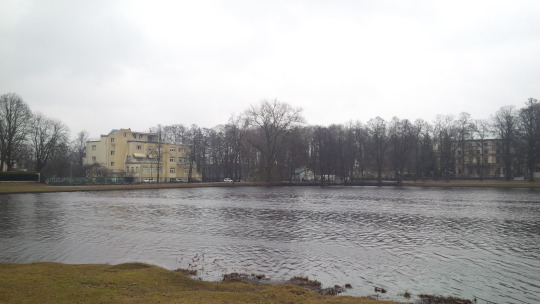


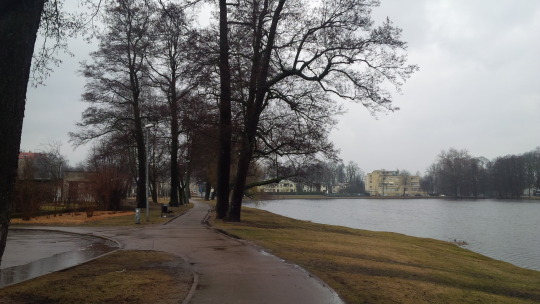
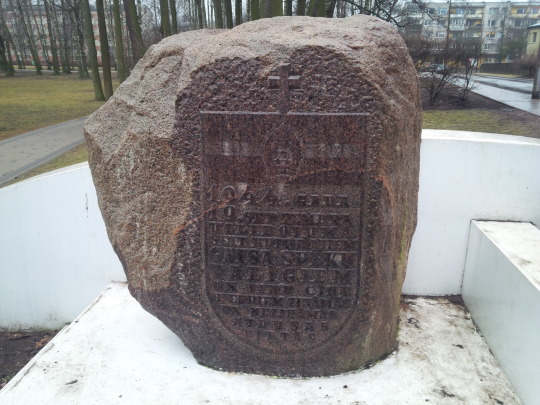
Having walked around the pond, we headed straight down Mārupes iela where there was a mix of residential buildings and student housing for Rīgas Stradiņa universitāte, the country’s most famous medical university named after famous Latvian surgeon Pauls Stradiņš. We also passed one of the city’s few Baptist churches, one of the “Coffee Tower” cafes which Konstantin mentioned tried to buy the water tower, and a Rimi.
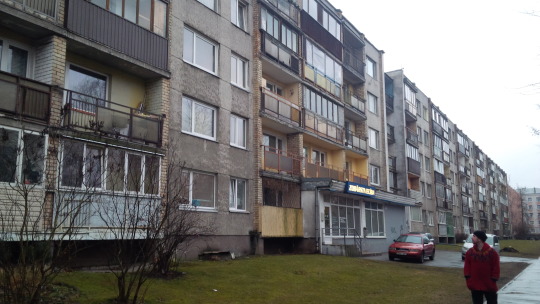
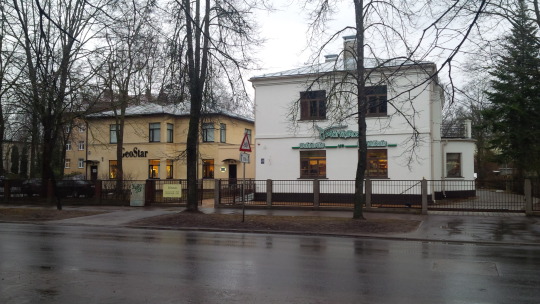
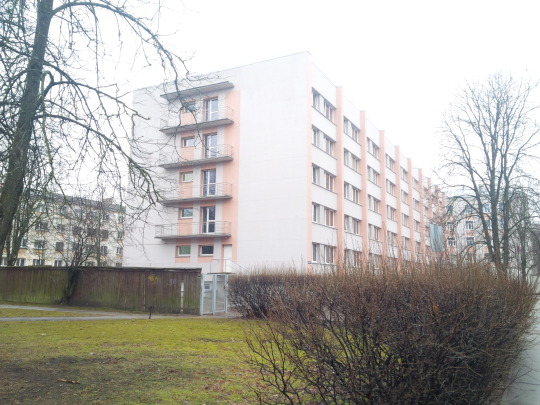
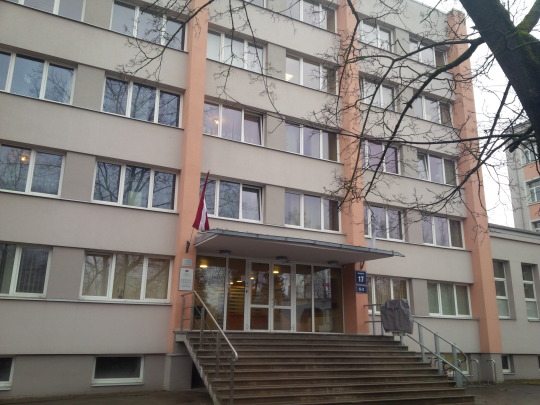


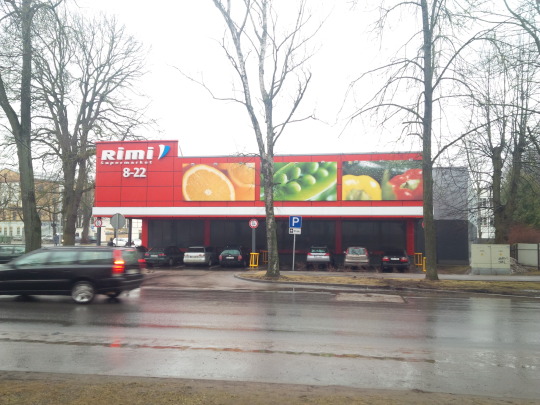
We turned left onto Leipājas iela, where we saw some graffiti that warned us: “beidz izdomāt melus” (stop making up lies). Within a few minutes we were standing outside of Sv. Alberta baznīca, an important part of Rīga’s Catholic community. Originally intended to be built in French Baroque style, starts and stops to the construction resulted in the somewhat unique final design. Across the street behind the brick wall was the many historic buildings on the campus of Stradiņa klīniskā universitātes slimnīca (the university hospital). Unfortunately we did not have the opportunity to explore the campus, but we were so wet and cold at this point that we were ready to take the bus to our final destination: Uzvaras Parks.




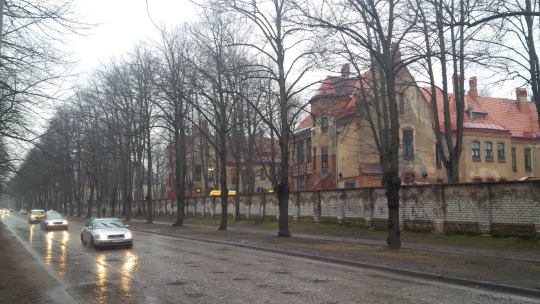
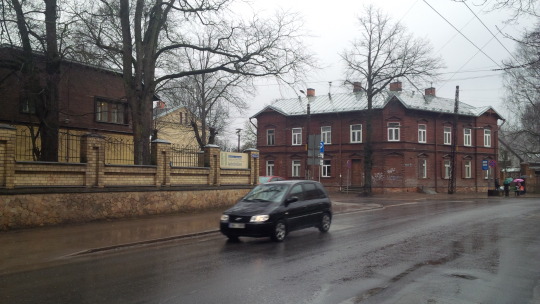
Since turning towards the market, our path had looked like this:
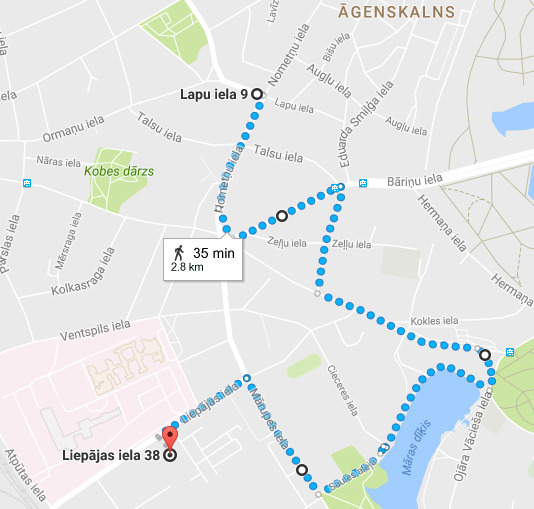
We got off at Slokas iela in front of Zelta Boulings, Rīga’s most popular bowling alley with some of the most surpisringly good pizza found in the city. We backtracked a bit down Uzvaras bulvaris to come to our final stop in the Āgenskalns and one of the city’s most controversial locations: Uzvaras piemineklis (Victory Memorial).

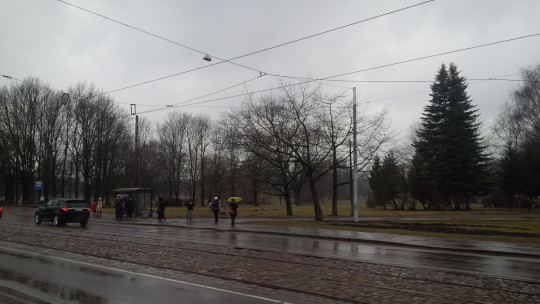

While the end of WWII and the defeat of the Nazis is celebrated throughout the world, many in Latvia (particularly ethnic Latvians) see the end of WWII as the beginning of the Soviet Union’s occupation of the country which included the forced deportations and murders of tens of thousands of Latvians. The monument was built in the early 1980s and is one of the most physically impressive sites in the entire country, but there have been many calls to demolish it as most other Soviet-era statues were at the re-establishment of Latvian independence. In fact, two ultra-nationalists even tried blowing the monument up in 1997, but ended up dying with the statue mostly unharmed. The site is especially important to the city’s ethnic Russian community which makes up nearly a majority of Rīga’s residents, many of whom had family who fought proudly to defend their country against the Nazi invaders. Many ethnic Russians feel alienated and left behind by the Latvian government's policies since 1991 regarding citizenship and language, and removing the statue would inevitably cause significant tension. For the foreseeable future the statue will remain as a divisive symbol which means many things to many people, and I will write more about the issue for the upcoming May 8th/9th celebration of V-E Day. What is undeniable, however, is that the Soviets knew how to make impressive and awe-inspiring statues.





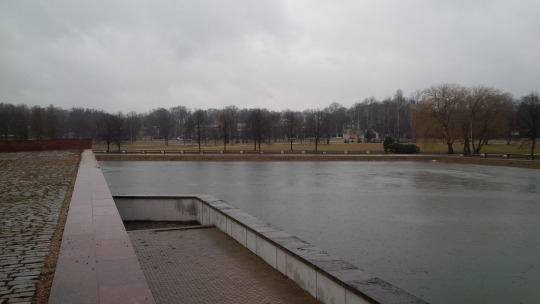


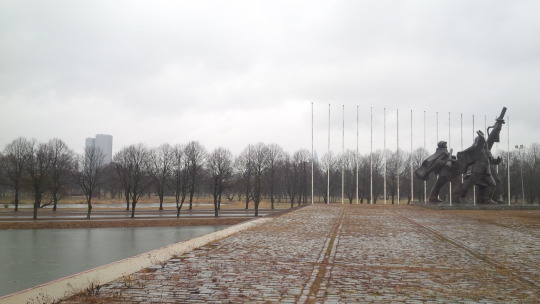
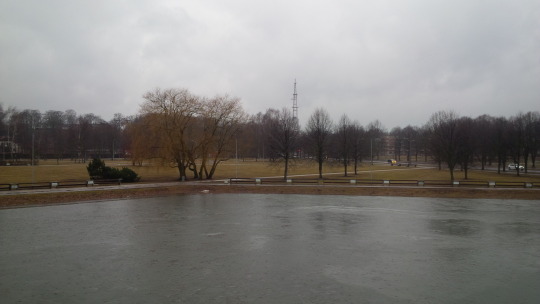
The final part of Āgenskalns that we skipped over was the rest of Uzvaras parks, but we were so cold and wet by now that we decided to go home. Plus, the rain was so heavy by now that the pictures we would have taken wouldn’t have done justice to the beautiful park. Instead, I will cheat with a few pictures we took of the park from last spring.



I hope that these rainy and dark pictures haven’t discouraged you, because visiting Āgenskalns is an absolute no-brainer regardless of your personal interests. While I usually recommend visiting certain neighborhoods to certain people for various reasons, Āgenskalns is one of the only ones I can suggest without any hesitation or second thoughts. If you’ve been in Rīga for any significant amount of time I’m sure you’ve alresdy spent some time here, but if you somehow haven’t yet wandered across the bridge to Pārdaugava then it’s time to come and visit.
A few random observations:
While most people I know who have lived outside of Rīga’s center have told me that they don’t do much in those neighborhoods aside from living and do most other things in the center, most of the people I know who live in Āgenskalns spend a significant amount of their time there. This is unsurprising considering how much there is to do and see here, but it really almost feels like a separate city with a somewhat different feel to it.
That being said, Līga and I have spent surprisingly little time in Āgenskalns. Although there’s so much to do, I have usually seen it from the windows of busses going to and back from work at the LU Pedagogy Faculty in Imanta. From Ķengarags it takes just a tiny bit too long to get to compared to the center where you can find almost anything that Āgenskalns has, but if I already lived in Pārdaugava I’m sure I’d spend more time here than time across the bridge.
Although we thought that winter had just about completely passed at this point in mid-March, we woke up this morning in mid-April to fairly heavy snowfall. To say that winter/spring 2017 has been a curveball would be quite an understatement.
And that’s it for now. I apologize that this post has been a bit longer than the others, but there is just so much to show and talk about in Āgenskalns that I didn’t want to leave anything out. Also a huge special thanks to Konstantin for contributing so much historical information about the neighborhood and its buildings, another reason why this post is a bit longer than the others. He’s planning on coming with us more regularly on our walks through the neighborhoods, and he might contribute some other posts in the future about urban exploration and other Rīga-related topics. Until next time, let’s hope that spring will soon finally stick around!
Nākamā Pietura: Atgāzene!
(Edit: Thanks to Māris Goldmanis from the fantastic Latvian History blog who wrote in with additional information a bout the state archives and the TV tower after the post was first published)
#agenskalns#Āgenskalns#riga#Rīga#Latvia#Latvija#soviet architecture#architecture#art nouveau#latvian history#old riga#Rīgas pilsēta#Vecrīga#Vecriga#water tower#city exploration#urban exploration#urbanexploration#urban explorers#urbandecay#abandoned buildings#abandoned places#Рига#Pārdaugava#riga stradiņš university#z-towers#uzvaraspiemeneklis#uzvarasparks#Латвия#public transit
2 notes
·
View notes
Text
My Neighbor Fen’harel Chapter 7: Why
Read full story on my AO3.
The rest of the week was relatively uneventful. Emmy wasn’t plagued by any more unwanted dreams, and Solas avoided conversations in his bedroom, so she hadn’t heard him again. Fen'harel hadn’t e-mailed her since their last chat, not that she checked multiple times a day. Darcy had adjusted to the new apartment. Everything was officially unpacked.
As for work, the days went by with a mixture of transcriptions, digitizing of old photos, and working through a particularly extensive collection, which had come in shortly before she had started, centered around the Hero of Fereldon. It was interesting, but there was a lot for her to work through. On top of that was the usual e-mails, entering of meeting minutes, and general reference questions sent her way by librarians when they needed extra help or had a patron who wanted access to particularly delicate materials, something her or Merrill would need to supervise.
Today was a Friday which meant a new shipment of donations had come in early that morning. She’d arrived at work by 6 to meet the delivery and since had been working through it with Merrill. As usual, much of it was things that they had no use for. One only needed so many diagrams of old toilets after all. Part of preserving history was deciding what took priority since it was simply impossible to properly store and catalog every single bit of it.
Merrill spoke behind her, “Another toilet. By the Dread Wolf, how many of these are there?”
Emmy snorted, “There have been an awful lot of them with this one. You’d think we were receiving donations from a toilet factory or something. Whoever this private collector was their grandparents must have had some odd fascination for them. Or a kink.”
There was quiet for a moment, “That’s a thing? How does…”
Emmy finished up cataloging the last bit of paper in the box in front of her. When she’d finished typing in the information, she tucked the document into its correct pile and stood, “I’m not sure I want to know, but I’m fairly certain it’s a thing. There’s a kink for everything.”
She glanced over at Merrill as she went to grab a nearby cart. Merrill was shaking her head and mumbled, “Sometimes people confuse me.”
“That makes two of us.” Emmy started moving her document piles onto the cart as she asked, “Ready to take the stuff down? We might actually be out of here by five for once.”
Merrill laughed as she stood to gather her piles, “Oh, I wouldn’t know what to do with myself if that happened.”
When they got to the elevator Merrill didn’t question why Emmy chose not to use it. Merrill knew her habits. Instead of using the elevator, she would push a cart into the elevator, hit the appropriate button, and then take the stairs and meet the items. It was never an issue. The elevator was ridiculously slow. Still, Emmy had braced herself for questions the first few times. When none had come, she’d started to relax. The lack of prodding was just another thing to love about her new co-worker.
Just as she was reaching the bottom of the stairs, the elevator dinged and the doors slid open. Merrill pushed out the cart and looked up, then her eyes went past Emmy’s shoulder, and she beamed.
“Professor Evans! It’s been a while.”
Emmy’s stomach dropped as she turned to find the last man she wanted to see. He stood holding a medium sized tome in his gloved hands. On his lower half, he wore pants that she refused to acknowledge flattered his thighs and sculpted rear. On top, he had a neatly tucked white button up under a dark vest; the sleeves had been rolled up revealing the lightly freckled skin of his forearms.
At Merrill’s words, he had turned his head to look at them. She only caught a flash of his eyes on her before they went to Merrill and he gave the woman an easy smile, “Hello, Merrill. It has been a busy first week back, so I have been unable to make it here much.”
Emmy’s eyes narrowed, and she frowned, “This isn’t a public part of the archives. These items are—”
“I have been given permission. I am well aware of how to handle such things.”
Merrill pushed the cart forward, cheery and completely unaware of the tension that sparked in the air, “Professor Evans has a lot of experience handling old documents. In fact, he has been able to teach me a few new things.” She laughed as she pushed the cart to the area where the first pile of papers was to be stored.
“Be that as it may, these are my responsibility now and—”
He spoke over her as his eyes went back to the book, “Why is this filed under the fall of Arlathan?”
She ground her teeth, “Excuse me?”
“It seems to me this would be more suited under something to do with Tevinter history.” Without looking up, he carefully turned the page and added, “It would perhaps aid you with your answer if you came close enough to see the item in question. I would not bite you if you did.”
She noted he hadn’t said he didn’t bite. She couldn’t help but think it was because she knew he did bite, that he wanted her to be reminded of those circumstances when he had bitten her. How many times had she woken up pleased with the light mark he had left behind on her skin?
“Is there a problem?”
Of course, now his eyes were on her, intent as they took in her face. The feeling of heat that rose to her cheeks made her blood boil.
Damn him.
When she spoke she kept her voice cool, “Just a tiny, inconsequential memory, nothing worth note. Honestly, it’s surprising I even recall it.”
A hint of something flashed in his eyes before they quickly flicked back to the book, “I see. In that case, are you going to come look or shall I start reading passages out loud.”
With as much dignity as she could manage she stormed over to him. The way he held the book forced her to move close to see the text, close enough that she could feel the heat of his body against her skin. It was like sunshine on a warm day and his scent—
Traitorous. Horrible, stupid body.
She forced her eyes to focus on the text in front of her. Ancient Tevene still was not her strongest area of expertise, but she was getting better. As she translated it her mouth moved unconsciously going over each word.
When he spoke, it was hushed so that Merrill couldn’t hear it from her place down the stacks, “You still do that thing with your mouth when you translate.”
At his words, her eyes flicked up to meet his. He was looking at her with that piercing gaze she knew so intimately. The one that had always made her feel more bare and exposed than any time she had been nude with him.
She stood there completely paralyzed by his examination, unmoving even as the voice of reason screamed at her she needed to back away. Even as it reminded her that, in her study of the book, she had pressed herself against his arm and this was not good. Tendrils of longing had already started to wind their way through her, thick and overwhelming.
When she managed to push out words, they were much less chastising than she’d intended. Her body continuing its treachery, “I fail to see how what my mouth does is any concern of yours.”
His eyes flicked to her lips then back to the book, “It is distracting.”
“Oh forgive me, I thought you were here out of professional interest. I will strive to spare you from temptation in the future.”
“Spare me?”
“Yes, temptation is the road to all things bad after all or something like that.”
She saw his fingers flex against the cover, “How do you know I wish to be spared?”
Her heart did an uneven thump in her throat, “Excuse me?”
“I believe you heard me, but I will repeat,” his face remained completely neutral, but she greatly doubted she was holding her composure nearly so well, “How–”
Merrill’s voice chirped in from his other side, “All filed.” Merrill’s eyes went to the book he had been holding, the book that the two of them hadn’t even really addressed, “You two still figuring out the filing for that thing?”
The suddenness of Merrill’s interruption finally got a reaction from Solas. It came in the form of the slightest jump, but it was enough that his arm temporarily knocked against one of her breasts. The action sent a jolt of electricity down her spine and had the small hairs on her nape standing on end.
At least it was enough to finally get her to put space between them. Her voice was impressively neutral when she spoke, “I recognize the text now. It is written by a Tevinter, but it is about the fall of Arlathan. The man was traveling and saw aspects of it, which is the key interest in the diary. Therefore, it is prudent to file it here instead of amongst things related to ancient Tevinter. The rest of the diary holds nothing that we didn’t know about Tevinter through other texts.”
She heard him inhale as he shut the book and placed it back in its proper spot. Then he pulled off his gloves, and she saw the smallest hint of a tremble in his fingers. It was childish, silly, but it made her smile.
Then he spoke, and her smile left, “I wonder, why you assume that this man’s words are fact. We know the Tevinters have a habit of taking and twisting history to their ends, especially when it comes to the People.” As he pulled off the last glove he turned to face her, “I do not mean insult, I am simply curious if you have reasons or are simply taking the words of a dead Tevinter as truth.”
How dare he. He comes into her archives and questions if she is doing her job properly. After all, he had done to her. After everything, he pulls this shit. Arrogant son of a bitch.
“Are you suggesting that I don’t do my research?”
“Not necessarily. I simply was wondering at your reasoning behind believing the diary contained truths instead of made up tales based on things Tevinter found and stole as their own.”
She was surprised that fire wasn’t coming out of her ears in some cartoonish mockery, such was the rage that boiled in her blood. She wanted to wipe that fucking calm look off his face, to push him against the shelves and kick his legs wider. Then she’d put her knee in the little triangle of his groin and pull herself up him, making him grunt with pain.
She’d rip open the collar of his shirt and put her hands around that long graceful neck of his. Then she’d squeeze and squeeze as he struggled beneath her. The scent of his skin, sandalwood, books, and ink, filling her nostrils as she felt the heat of him under her fingertips.
“What are you imagining, Miss Lavellan; your expression is,” He paused a beat, and his tongue darted out to lick his lower lip, “filthy.”
Totally forgetting Merrill was standing right there, she spoke, and her voice came out so husky it would make a phone sex operator sound like a nun, “Bare hands on your neck, strangling you.”
His eyes went dark, “Is that your new kink.”
“It seems to be one you alone bring out in me.”
His pupils got even bigger, eyebrows lifting as he opened his mouth then closed it. It would appear that she had rendered him speechless. It was beautiful.
Merrill cleared her throat, eyes wide as she looked between the two of them, “Are you two–”
“No.” They answered at the same time, in the same tone, as they continued to stare each other down.
“Right. I’m going to uhm… go take the cart back now.” Merrill rushed away, and Emmy hardly registered the ding of the elevator as she went.
With one wide stride, Solas moved, so he was so close to her that the tips of his perfectly polished shoes touched her run down brown boots. She swallowed, her knees feeling like jelly. She wanted to slap him, to tear his eyes out, to rake her nails along his skin, to have his mouth on hers, to devour him as he devoured her in return.
When he spoke his tone was so cool and collected you would think they were two old friends having a conversation over coffee about the latest book they’d read. “Why are you here, Em?”
Her heart clenched at the shortened use of her name, “Don’t call me that.” Then a thought came to her and she glared at him as best she could, given how close he was, “Why? Do you think I came because you were here? That I hunted you down or something?”
Finally, an emotion crossed his face, a small hint of surprise chased quickly by the slight tilt of his head, “Did you?”
“Not that it’s any of your business, but no, I didn’t. After it finally sunk in that you’d disappeared, I didn’t look, not even once.” Then her voice fell to a whisper, “It hurt too much.”
“Em.”
She saw his hand move in the side of her vision and took several large steps back away from him, “Stop calling me that, I hate it. And I meant it hurt too much then. When it first happened. After a few months…” She paused then forced the lie out even as her body seemed to protest it, “I just didn’t care.”
With one last glance in the direction of the nearby stacks she turned from him without allowing her eyes to look at his face, only sweeping over his chest, “You know what happened. Everyone knows. After all of that, I just wanted a chance to have a normal life. Try to have a new start.” She gave a soft bitter laugh as she started walking away, “Only my luck could have that attempt end up like this.”
Sure she was no longer fighting to “save the world,” but her life had still managed to remain complicated in creative and messed up ways. Just as she was starting up the stairs, a hand was on her elbow, firm but not enough that she couldn’t yank free if she wanted to.
“I am sorry, Emmy.”
For some reason she didn’t pull away but froze, only moving enough so she could turn her head to look at his chest, the strong line of his jaw, “It was a long time ago. I got over it a long time ago. There’s no need to go there; I don’t want anything from you.”
A lie. Such a huge lie that it burned like acid on her tongue.
“I know, and it is selfish of me, but I need you to know. What we—” She saw his deep breath in the shuddering lift of his chest, “What I felt, it was not a lie.”
His words made her knees go weak once more. She wanted to sink to the floor with the force of them pressing on her. Part of her wanted to really talk to him, to ask him all the things she had wanted to ask him since the day he left. To discuss everything like the two adults they were. But a bigger part of her couldn’t go there because she was terrified it would break her. Only recently had she started to truly feel like she was piecing herself back together again after everything, she couldn’t shatter again.
Instead of being an adult and facing her feelings she pried her arm free as she said, “Are you done or was there more you needed to say to try to make yourself feel better?”
He frowned, “That was not my intent.”
“Wasn’t it? What was your intent then?” His mouth opened, then shut again, and he shifted. She turned from him once more, “As I thou—”
“I would like if we could be civil. I do not expect you to forgive me. I do not expect your friendship or anything else from you but…” She had stopped on the steps, and he paused to find the right words, “I would not make your life harder if I could help it. You must understand that I have my reasons for being unable to leave, if I could, I would.”
Why? Why did those words sting so terribly? If he left that would solve her biggest problem, everything would be simple again or as simple as they could be. She could start trying to build a life for herself. A life without him in it.
He wanted to run from her. Again.
She turned to face him; now she stood three steps above him so was able to look down her nose at him, “Tell me, is it habitual for you to run from all your problems or just from me?”
From the look on his face, she was fairly sure she’d landed a solid punch. He took a deep breath then turned towards the elevator. She thought for a moment he would simply leave, but he stopped before turning back and crossing over to her in a few quick steps. He stood on the bottom step so his face was more even with hers and she was within a foot of him.
“You are the only thing that has ever terrified me enough that I felt I had no other choice. Wrong as I was.”
Despite the fact that his words made a familiar desire pool in her lower belly she managed to keep her tone even, “Oh yes, I’m completely terrifying. The thing of nightmares and you always had a choice, Solas. You could have said something, anything. Broken it off like a normal person. Just vanishing was–”
Now when his hand came up to brush a knuckle across her cheek, she didn’t jerk from him or slap him away. She allowed it even as it made her forget how to breathe. “Cruel. Inexcusable. Unforgivable.” He let his hand fall back to his side with a soft sigh, “All would be appropriate words in this case.” He started to turn and go but then paused, “Emmy, you are not of nightmares. You are of the sweetest dreams; the ones that I never even knew I desired, knew I needed, until you.” He shook his head, “I am sorry. Good night Emmy.”
With that he turned from her, once more going to the elevator. She stood in frozen silence as he waited for the doors to open. It felt like an eternity as she fought for words to say, fought to still the racing of her mind. She felt her body shaking and hated herself for it.
When he did finally step into the elevator, he looked at her one last time. His expression visibly pained, tormented, and so lonely it made her ache. She didn’t move, though something deep in her core was pushing her, telling her to go to him. She couldn’t. She couldn’t let herself surrender to him like that again, never again.
The doors closed and he was gone. She stood there for another minute, took a deep breath, and pulled out her phone. She scrolled through her contacts with shaking fingers till she found the name she wanted. Then she selected it and started up the stairs, phone ringing in her ear.
After she was halfway up, a voice sounded in her ear, “Emmy, so you do know that you can use the phone for more than just texting! It’s a miracle.”
Despite her best efforts, her voice shook as she said, “I would take you up on those drinks now.”
“I’m getting on my coat now.” There was a beat and some rustling from the other end of the line before a hesitant, “Are you alright?”
“I’ll be fine. Just meet me at the Singing Maiden, if Bull is with you bring him along too.”
“As if I could stop him. The man already has his coat on and is half out the door.”
She smiled as she reached the top of the stairs and headed down the hall to her office, “Good. I’ll text Sera.” She paused a beat, “And Dorian?”
She heard the slamming of a car door in the background, “Yes?”
“Thank you. You’re the best.”
“Naturally.”
She gave a small genuine laugh, “See you soon, Dorian.”
With that, she hung up and went to gather her things.
#solavellan#solas#lavellan#solavellan fanfic#solavellan modern au#modern au#professor!solas#dragon age fanfiction#dragon age au#university au#merrill#dorian#my writing#my neighbor fen'harel#why you do feels solas#why#this was supposed to be my light fic#feels#suggestive flirting#flirting#i hate you but i love you#why do you do the thing
9 notes
·
View notes
Text
%news%
New Post has been published on %http://paulbenedictsgeneralstore.com%
News top stories daily news hot topics Justin Trudeau: Las buenas noticias, y las malas, para el primer ministro de Canadá
News top stories daily news hot topics
.spinner-container width:25%; top:20px; left:50%; margin-left:-12.5%; border-radius:8px; position:fixed; text-align:center; box-shadow:0 0 10px rgba(0,0,0,0.24); background:#fff; overflow:hidden; .spinner-container p font-family:'Roboto', Arial, sans-serif; color:rgba(0,0,0,0.87); margin:12px 0 16px 0; padding:0; font-size:12px; .spinner-container img width:22px; height:22px; margin:16px 0 0; padding:0;
Translating…
Media playback is unsupported in your instrument
Media caption“Canadians voted in favour of a progressive agenda” – Justin Trudeau’s victory speech
High Minister Justin Trudeau has retained energy in Canada’s election but lost both his majority and – by a minute margin – the favored vote. Here is a breakdown of the fitting files for his Liberal occasion – and the atrocious.
News top stories daily news hot topics Comely files – he’s mild in energy
It was once a cosmopolitan election battle for the Liberals but there was once the sense leisurely on Monday evening among occasion devoted in Montreal that they can also now breathe a cramped much less difficult.
When TV networks started projecting a Liberal minority, supporters at the election evening headquarters erupted into chants of “four more years” as one scheme of relief passed by technique of the crowd.
“The Liberals did better than we belief they would,” acknowledged supporter Brian, who selected now not to give his closing name, announcing he had been spooked by polls that advised a tighter plod.
Extraordinary Liberal MP Marlene Jennings says voters “indulge in shown they mild indulge in believe in the Liberal authorities and in Justin Trudeau, and they positively didn’t desire a Conservative authorities, now not even a minority authorities”.
Peaceful, Ms Jennings conceded she had grown frustrated staring at the campaign get sidetracked by “so-known as scandals” at some level of the closing few weeks.
“There were times at some level of the campaign the place I needed to desire the Liberal strategists and shake them and utter: ‘Why don’t seem like we speaking relating to the enormous things we have got done over and over?'”
News top stories daily news hot topics Scandalous files – his star energy is diminished
Mr Trudeau had an exceptionally lengthy honeymoon by most political requirements – but his status has clearly dimmed with the Canadian public.
The place did he stumble?
Media playback is unsupported in your instrument
Media captionFour years of Justin Trudeau in two minutes
Even earlier than the election campaign started on 11 September, his approval rankings had slipped.
The predominant peril with the Canadian public came after a disastrous abroad outing to India, which took roar against a backdrop of relate-ops showcasing the Trudeau family in account for feeble Indian outfits.
Then came the SNC-Lavalin affair – an ethics scandal connected to makes an strive to stress a ragged attorney basic to carve inspire a deal for a firm going by technique of a corruption trial, which extra tarnished Mr Trudeau’s personal stamp.
That ragged attorney basic, Jody Wilson-Raybould, was once booted out of the Liberal occasion by Mr Trudeau.
In opposition to the percentages, Ms Wilson-Raybould ran and obtained as an self sustaining in her Vancouver utilizing.
Image copyright Reuters
Image caption Jody Wilson-Raybould
She is a vocal critic of Mr Trudeau and might per chance per chance wait on as a reminder of that scandal in the Residence of Commons.
Within the end, revelations that Mr Trudeau wore blackface – broadly seen as a racist caricature – on as a minimum thrice shook the Liberal campaign and compelled Mr Trudeau to ask Canadians to forgive him for his past misbehaviour.
News top stories daily news hot topics Scandalous files – the Liberals lost the West
The prairie provinces of Alberta and Saskatchewan grew to change into completely Conservative blue – rather than one Recent Democratic Celebration (NDP) stronghold in the town of Edmonton.
That blue wave helped the Conservatives produce nearly 30 seats in Monday’s election, taking them from 95 to about 122.
The Liberals were by no methodology going to brush these deeply Conservative areas. Even at the peak of their status in 2015 they simplest held a handful of seats in these two provinces.
However now Alberta and Saskatchewan indulge in grew to change into solidly faraway from Mr Trudeau’s occasion amid one scheme in western Canada that its interests are now not represented in Canada’s capital of Ottawa.
With closing results mild rolling in early Tuesday morning, the Conservatives furthermore had a minute lead in the favored vote – 34.5% to the Liberals’ 33%.
That didn’t plod the dignity of Conservative leader Andrew Scheer who acknowledged in his speech to occasion devoted that “more Canadians wanted us to bewitch than any diversified occasion”.
News top stories daily news hot topics Scandalous files – the Bloc bounced inspire
The Bloc Quebecois has furthermore had a resurgence.
Voters had relegated the occasion calling for sovereignty for Quebec to the sidelines in the closing two elections – but its fortunes grew to change into under the recent management of Yves-Francois Blanchet, and they more than tripled its seat depend, from 10 to an estimated 32.
Image copyright Getty Photos
Mr Blanchet campaigned under the slogan “Quebec, c’est nous” or “We’re Quebec”, and on being a solid suppose in Ottawa for that province’s interests.
The occasion, which simplest runs candidates in Quebec, is at odds with Mr Trudeau on disorders like the province’s controversial secularism law – Bill 21 – which prevents judges, law enforcement officers, teachers and public servants preserving some diversified positions from sporting spiritual symbols such because the kippah, turban or hijab whereas at work.
Mr Trudeau did provide an olive branch to those Canadians who rejected the Liberals at the pollfield, and acknowledged he had heard the frustration from prairie voters loud and sure.
“To of us that did now not vote for us, know that we are going to work daily for you,” he acknowledged. “We are able to govern for all individuals.”
News top stories daily news hot topics Comely files – he can mild govern with a minority
Mr Trudeau will need the enhance of diversified parties to pause his promised “progressive agenda” if he desires to lift on to energy.
One likely ally is the NDP, who might per chance per chance help the Liberals to outlive key self belief votes and to skedaddle legislation.
However that enhance comes at a label.
Image copyright Getty Photos
Image caption From left: Justin Trudeau, Andrew Scheer and Jagmeet Singh
NDP leader Jagmeet Singh has already residing out his occasion’s laundry list of priorities in a minority anguish: enhance for a nationwide pharmacare knowing, investments in housing, addressing student debt, decreasing cell phone and cyber web funds, action on climate, and raising taxes on the wealthiest Canadians.
However Mr Singh’s roar is much less sure on the Trans Mountain pipeline venture, which might per chance per chance triple the capacity of impolite oil the most up-to-date pipeline carries to the west hover.
Mr Trudeau’s Liberals enhance the venture, announcing it is in Canada’s nationwide hobby.
In his speech to supporters leisurely in the early hours of Tuesday, Mr Singh vowed his occasion would play a “sure fair” in Ottawa.
However enhance for a minority authorities furthermore most incessantly has an expiration date.
On moderate, minority governments in Canada closing about a yr and a half of to 2 years, noteworthy shorter than the identical outdated four-yr majority timeframe.
News top stories daily news hot topics Comely files – voters pause desire climate action
The Conservatives had pledged to without prolong repeal Mr Trudeau’s signature climate policy in the occasion that they came to energy.
However now it feels like the federal carbon tax – imposed on four provinces that did now not already indulge in their possess cap-and-trade programme or label on carbon in roar – will stay one more day.
It is miles now not going to be too subtle for Mr Trudeau to stable enhance from during occasion lines for his climate insurance policies.
Media playback is unsupported in your instrument
Media captionWhat’s more indispensable to Canadians — the financial system or the ambiance?
The NDP, the Bloc Quebecois and Canada’s Greens, which added a seat in Atlantic Canada, all campaigned on taking action on the ambiance.
“Chances are you’ll per chance per chance indulge in gotten asked us to demonstrate scheme more imaginative and prescient and ambition as we take care of the ideal anguish of this period – climate trade,” Mr Trudeau acknowledged in his victory speech.
“That is precisely what we are going to pause.”
function gtElInit() var lib=new google.translate.TranslateService(); lib.setCheckVisibility(false); lib.translatePage('en', 'es', function (progress, done, error) );
0 notes